I'm Anna Zukowska, and I'm currently in my second year at the University of Derby studying Graphic Design. This is my blog for the Professional Practice module.
Don't wanna be here? Send us removal request.
Text
Week 12 - Presentation and Reflection
Our Outcomes:
Over the Easter break, I finalised my final outcome for the group project, and edited it onto a staircase wall; this was most appropriate location I thought as the image is bound to get seen a lot, and as it represent such an important issue, this is exactly what it needs - exposure. This is my final outcome:

I’m content with my final outcome as the imagery is clear, and makes the message easily understood as it shows the potential aftermath if people don’t use their freedom and choice in the right way, and help to save the environment. I am also pleased with the outcome because I got the chance to create an artwork about an issue I care deeply about.
These are the rest of the group’s outcomes, in the following order - Alison, Karolina, Tom, Georgia and Anniko.

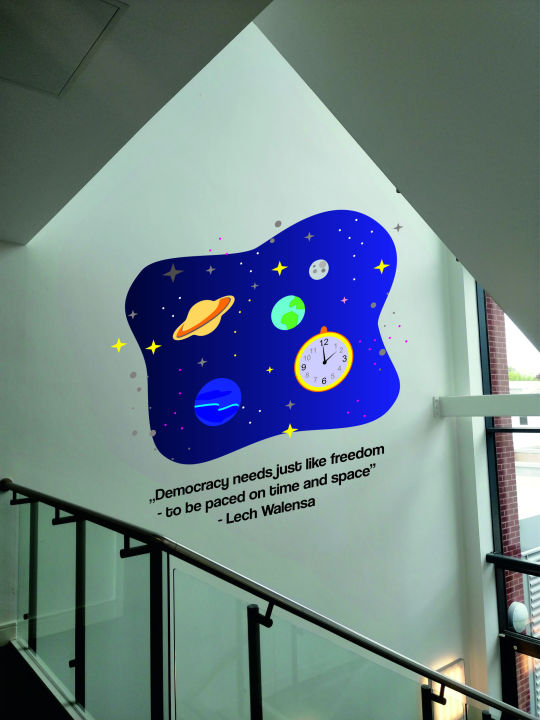

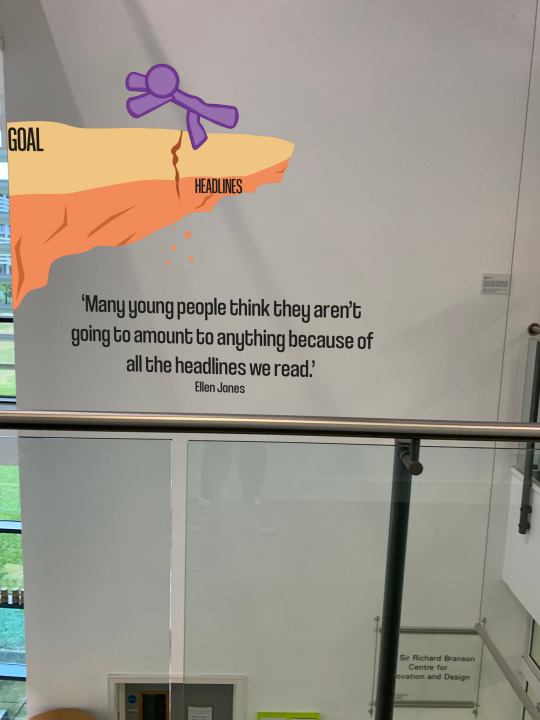
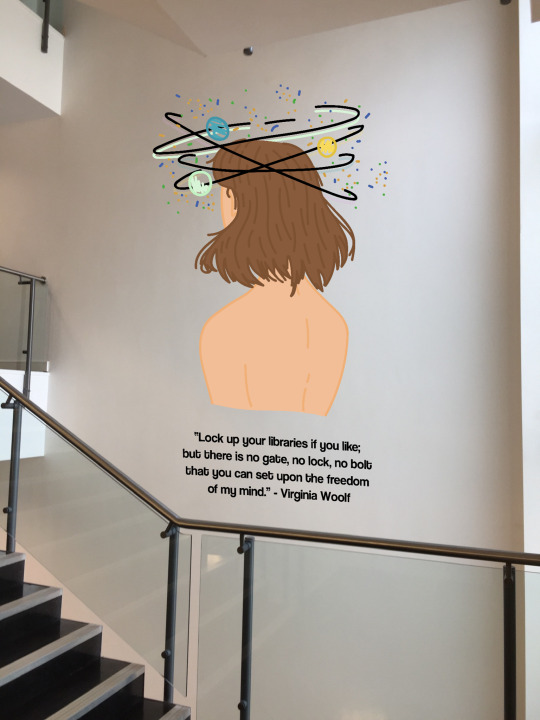
I personally think we responded well to the brief as we approached the theme of ‘birdhouse’ in a different way than most groups have, and I think we’ve chosen topics that would be relatable to students, tutors and visitors - it’s important to build a connection with the audience, and that’s exactly what we’ve done. In addition, I think we kept to the guidelines we decided to work with successfully too because all images look consistent with the same style of design; this makes it clear to the audience these images all link are a part of the same project.
The Presentation:
Originally Alison was in charge of putting together the presentation, however something came up and she didn’t have enough time so I offered to do it as I, on the other hand, had time to spare and was happy to help out. The presentation consisted of our journey throughout the project, starting at the beginning with the mindmaps and thinking of our idea, to our progress and the final outcomes at the end. I also created a script, to ensure people knew what they were saying, as well as to help out less confident speakers such as Karolina and Anniko a chance to revise what they’re supposed to say.


The script; my parts were in green.
We met up on the 30th of April for a final group meeting – this is when I showed Tom, Georgia and Anniko my presentation and got them to help me finalise it by checking if I missed any information out. We also decided then who was saying what; we used colour coding to split the script. We decided that we each should talk about our own idea and me, Georgia and Tom will cover the rest of the dialogue. The presentation can be viewed here: https://drive.google.com/drive/u/0/folders/11cBavW12y6W1NwXtFvS2_0RfFLb5mxvC.
The presentation took place on the 3rd of May. It was really interesting to see how everyone responded to the same brief - I particularly enjoyed the project where students and tutors got transformed into bird and dinosaur characters, and the one where the birdhouse became a safe space for anyone experiencing issues and needed a place to get away from it all. Our presentation went really well I thought - we had no errors, everyone spoke when they should have and the feedback we received was really positive with some students commenting on how they found our project inspiring and that it’s gave them a lot to think about in regards to how they treat their right of freedom.

The group after the presentation, with our money.
Overall, I’d say we worked really well as a team; this is due to us knowing each other previously and Anniko easily being able to adapt to us too. We met up very regularly and kept each other up to date with our progress, and ensured others’ were content with our work by welcoming feedback. Although at the beginning, we were unsure of Tom’s place in the group, he really redeemed himself by showing up to all the meetings after the initial pitch, and picking out our font as well as choosing an activist himself later on. We had no tensions or arguments within the group - although sometimes the feedback when commenting on each other’s work wasn’t always positive, we ensured we gave each other constructive feedback and helped to improve someone’s work if it was needed. I enjoyed the group work, as well as the project brief as I mentioned earlier I got the opportunity to create a piece of artwork about an issue I feel strongly about, and so did the others - it felt important creating design based on real life issues and struggles.
Review of the Module:
Reflecting back, I really enjoyed this module as I found it extremely beneficial. I loved learning about the industry in more detail because I never got the chance to do this; the things I’ve learnt have become very useful, such as finding out what the Careers & Employment Services offer which helped me to write my first graphic design CV, meeting up with a designer as I never got the chance to talk to a real life graphic designer before, and all the talks from professionals in different fields provided me with new knowledge and tips. I feel more confident about what I know about the industry now – I now know key skills employers look for from the Ian Cherry talk, how networking works and the importance of it from the Networking lecture, and have the key information about freelance work if I ever decide that this is the right path for me from the Self-Employment talk. I feel that I am a little closer to reaching my future ambitions now as I understand how to create a successful portfolio and have a good CV, and used that knowledge to create both, and this knowledge eventually helped me get the internship I was really keen on getting.
My action plan for now is to complete my summer internship as Graphic Designer with Digital Marketing Intern at Derbyshire Toy Libraries. I will use the new knowledge and skills learnt in this module and apply these to my internship; I will aim to keep in contact with the people I meet there as a way of networking and I will try to learn as much as I can about the role of a graphic designer in the industry, and apply this knowledge to my studies in my final year at university. I also want to carry on expanding my portfolio and really finding my own personal style and aesthetic, and just overall carry on working hard and staying determined and motivated as this is what got me as far in my journey as I am today.
0 notes
Text
Week 11 - Design Connections Event
The Design Connections event was held at 67 Bridge Street, and consisted of three talks that lasted fifteen minutes and a chance to network for a couple of hours afterwards. The three talks I attended were “How Graphic Design and Animation Fits in with Marketing and Filming" by Future Proof Films, “Opportunities within the Creative Industries upon Graduating” by Quad and “How to Develop an Artist-Led Practice” by UK Young Artists.

The first talk was led by Drew Taylour-Davis, director of Future Proof Films, a company set up by Taylour-Davis alongside his two film-making friends Sam Houghton and Robert Dawes. I have researched the company before the event, and found out that its aim is to create visually engaging video content for companies, brands and organisations throughout the UK and the world (https://futureproof.film/). The talk consisted of the students asking questions, and Taylour-Davis answering them, just like a Q&A session. The first question asked about how Taylour-Davis got into the industry he works in now: he said that he studied Film Studies at the University of Derby, graduating in 2015. He set up his companies shortly after with his friends, and still works there now. Next question asked about what the day-to-day in the industry looks like for Taylour-Davis: he oversees animation that other people create, as well as also creating animation himself. He specialises in post-production, which includes all stages of production occurring after shooting or recording individual program segments. After, a question about what role do graphic designers could potentially have at FutureProof Films came up: graphic designers would work on creating storyboards, animating – for those who are able to, creating lower third text and titles, and social media marketing so creating posts for Instagram, Twitter etc. Following this, the topic of working with students came up, and we found out that Taylour-Davis is very keen on hiring interns through the university’s internship scheme – he’s also very keen on hiring University of Derby students specifically as this is where he went to university of course. He then gave some tips about applying for internships, and stated that some knowledge is needed, but you mainly learn on the job, and you learn a lot – something new every day. The talk then moved onto freelancing, and specifically if he did freelancing himself: the answer is yes, from time to time on the side but finds it difficult to balance his company and freelance work at the same time. However, if the project and opportunity is worth it, he doesn’t mind losing sleep over it. Again, he gave advice how to get freelance work, and this was through networking – he said it was vital to attend as many events as possible and make contacts whenever you can; most of his company’s clients have come through networking, and not through advertising or Google search.
The next talk was by Adam Buss, the CEO of Quad which a centre for art, film and digital media (https://www.derbyquad.co.uk/). I am aware of Quad and what it does, and have in fact attended some exhibitions held there previously. The session again was a Q&A, however there was more advice with Buss’ personal experiences coming up frequently. The first advice he gave was that the industry expects designers to be multi-skilled, and recommends doing more of that whilst still at university as students have more freedom to explore and experiment; make the most of it is what Buss emphasised. This is because it’s important to inspire yourself, not just by your industry but by others – be inspired by as many artists and art forms as possible as this adds to the ability of being a multi-tasker. After this, the question about how to get into the creative industry was asked: Buss stated that it was important to find a job that consist of something you enjoy, and not take just any job offered without any thought. Having a plan isn’t always necessary also – there is no right or wrong way to start a career as it all depends on the person and what they look for in a job. Sticking to the theme of jobs, the question of what made Buss want to pursue a career in art came up, and we have found out that Buss originally wanted to be a financial adviser at age nine / ten, as he has grown up on council estate and seeing financial advisers in his area all dressed up in a full suit quite simply inspired him. However, this changed around the age of thirteen when his drama teacher recognised his performing skills; this teacher acted as a mentor for Buss and opened up a new window to the creative industries as he didn’t know much about them since he’s come from a working-class background. Buss emphasised how much he thinks that the creative industries are so important and earn a lot of to the UK industry. Then, the question of Buss’ first job came up, sticking to the same theme again: Buss’ first job was a role at the Student Union of the university he attended, where he overlooked the media, so the magazine and radio. He learnt a lot from this job – how to budget, meet deadlines successfully and how to market for different groups and audiences, to name a few. Again, the question of working with students came up as in the first talk: Buss stated that University of Derby graduates make up a third of the team at Quad. Most of them he saw prior to them being hired as they attended events, films, etc at Quad regularly, and made opportunities happen for themselves by asking about roles and showing interest. He also then said that he doesn’t believe the negativity and stigma around ‘millennials’ – the assumption nowadays is that young people are lazy, unbothered and not hard working, which Buss hasn’t seen in the young people he works with – in fact, he found the young people he works with to be creative, ambitious and always keen to learn and do more.
The last talk was from Vikki Jones, an Engagement Coordinator. Jones is a freelance youth engagement specialist – over the past decade she has worked with theatre venues, exam boards, national arts festivals and community programmes, all with the focus of getting more young people involved in practical arts and cultural activity. She’s also a fundraiser for UK Young Artists, a registered charity that champions the next generation of creativity, supporting collaboration and intercultural dialogue, ensuring a vibrant and diverse creative future for the UK (http://www.ukyoungartists.co.uk/). The talk happened on the same table as the previous one, so it followed the same format – advice from Jones and a Q&A session. Jones first described herself and her career, which in her words is a ‘portfolio career’ as she works four different jobs at a time. Her first job was as an unpaid dance intern in Nottingham; she said she had the opportunity to watch a project from beginning to end for the first time which was a really valuable experience. The first question asked was about what she finds the most challenging about her job: after graduating, finding something that separates you from everyone else who has done the same course as you, and not only from your university but universities all over the place. To solve this, she recommended that every opportunity should be seized, and don’t ever be afraid to introduce yourself and make contacts whenever possible – say yes to every opportunity. Then, the question of if you could give yourself any advice you could when you first started out, what would that advice be came up: to answer this, Jones talked about embracing your mistakes and not being afraid to make many as you learn from all of them; you won’t have the opportunity to once you are a few years into your career. Also, always research the company that invites you for a interview, to ensure you wear the appropriate attire – formal wear isn’t always needed. Lastly, the question about what is the most exciting about her job was asked, and this was the lack of routine and the unexpected nature; she likes having different jobs and having the opportunity to work on many different things at once.
In the afternoon, there was a chance to network with various designers as well as representatives from university such as the ones from Banks Mill Studios and Be The Boss programme. In preparation, I have thought of some questions which I thought would be useful to ask, resulting with the following list:
How did you get into this field?
How did you get involved in (company name)?
What does a typical day or week in your job look like?
What do you like most about your role?
What skills do you think are important in order to be successful?
What advice would you have liked to have heard when you were starting out?
Have you got any exciting projects coming up?
Due to the volume of students at the event and limited time, I have only managed to talk to one person, who was Nigel Brown, a Managing Director at Impromptu Software (https://www.impromptu-software.co.uk/). I have started the conversation by introducing myself, and making the atmosphere friendly by asking him how he was and how he was finding the event so far. I then used some of my questions to start a conversation based around his workplace:
How did you get involved in Impromptu Software?
“I found Impromptu Software myself in 1995 when I started work on the Impromptu Interactive Music System, which ended up growing into a full time business around 1998. So, year or so after, Impromptu Software Limited was formed.”
What does your company do?
“We develop apps and game across a variety of genres and create console, handheld, mobile and desktop software. So, we complete whole projects from design, development to review and publishing. We also do Project Management, speciality software audio design and create music and sound effects.”
What kind of clients have you worked with?
“We’ve worked with small local companies around Derbyshire, as well as high-profile titles such as Sega, Codemasters, Konami and EA. It’s a great mixture working with such a variety of companies as you just don’t know what to expect.”
Do you work in a studio, and what does your team look like?
“We are based at Banks Mill Studios, which I’m sure you’ve heard of. Currently there are five of us including me – so, there’s me, the Managing Director and Software Consultant, Helen who is the Financial Director and does all the Admin work, Keith who’s the Software Engineer, Robert the Development Operator and James who is the Game Designer and Programmer. However, we are on the lookout currently for Animators, Graphic Designers and Quality Assurance to join us. When we see talent, and we are just keen on getting that on board with us, and are always happy to expand our team with new faces.”
I then thanked Brown for his time and had to move on unfortunately; like I mentioned previously, this was due to the lack of time and large amount of students at the event.
I found this event very useful as it was a great confidence booster for me personally as I now know what type of questions to ask at a networking event, as well as being given tons of helpful advice from professionals to remember as I progress with my career.
Action Plan - Review from Week 11:
Following the Postgraduate study lecture, I wanted to research further about Postgraduate study in relation to my field, graphic design. I have gone back and used the Prospects website once more as I found it really useful last time due to the website having specific pages on each subject, including graphic design. I managed to find a page that was specific to a Master’s degree in graphic design: “Securing a graphic design job is tough, especially when you're fighting it out with other talented graduates. A postgraduate qualification isn't a prerequisite for a graphic design career, but a Masters can help you stand out from the competition.” (https://www.prospects.ac.uk/jobs-and-work-experience/job-sectors/creative-arts-and-design/graphic-design-courses) It then showed some top courses in the country that offer a Masters in graphic design, such as the University of Huddersfield and University of Central Lancashire, who both offer one-year courses that encourage to push the boundaries of graphic practice with the development of innovative and imaginative concepts and ideas. Of course, there was also a whole list of universities that offer the Master’s degree, and these are some that caught my eye:


These courses seem much more focused and specific, in comparison to the course I am studying now, so I think I would enjoy it more. If I were to apply to study a Masters degree, it would preferably be at another university, not at the University of Derby as I like having the opportunity to move to another new city and meet even more new people.
This specific course really attracted me – it’s at Nottingham Trent University. It’s called MA Brand and Identity: https://www.ntu.ac.uk/study-and-courses/courses/find-your-course/art-design/pg/2019-20/ma-branding-and-identity?utm_term=ART&utm_medium=Profile&utm_source=Prospects&utm_campaign=ART-Profiles, and it’s full time and Postgraduate taught.
“Brand creation is about attitude. It’s about creating and sustaining trust and giving purpose. It means delivering on promises and being relevant. The best and most successful brands are completely coherent. Every aspect of what they do reinforces who they are. Our Branding and Identity course offers you the opportunity to investigate one of the most dynamic, powerful and influential areas of professional graphic design. We believe that storytelling and conceptual thinking is at the heart of good branding. As part of this course you will produce highly considered research and enquiry into the strategies and overarching narratives that underpin this branch of design. Our aim is to challenge and support you to become a creative thinker, who has learned to plan and create brands that will speak with power and persuasion.
Key features
Develop a project tailored to your own personal interests and career aspirations
Engage with industry by undertaking short internships and studio visits
Work in our dedicated Art & Design postgraduate studio
Benefit from regular lectures from leading figures in the design industry
Attend workshops covering typography, visual language, branding, storyboarding and life drawing sessions
Opt for an additional advanced research module if you’re thinking of progressing on to PhD or Professional Doctorate study.”
The reason why this course really appeals to me is because it focuses on the area of graphic design I am most interested in, which is branding. I really like the sound of what the course involves; the lectures from leading designers, workshops covering all areas of graphic design, a personal project based on my interests and career aspirations and engaging with the industry with short internships and studio visits. However, what really discourages me from Postgraduate study is the cost – the funding isn’t as widely available as it is for Undergraduate courses. This specific course costs £8,000, and because it is only a year course I wouldn’t have to pay more, however I can imagine there are costs within the course for printing, visits etc.
I have then researched funding, to see if there is much help available; once more, the Prospects website became useful.
“For courses starting in 2018/19 you can get an English postgraduate loan of up to £10,609 towards your tuition fees, study costs and living expenses. This will increase to £10,906 in 2019/20.
The loan is not means-tested, meaning the amount you can receive does not depend on your financial background. You can choose how much you want to borrow, up to the maximum.
You must:
be a UK national or have settled status
normally live in England
have lived in the UK, Channel Islands or Isle of Man for the past three years
be under the age of 60 on the first day of the first academic year of your course
not already have a Masters degree or higher qualification.
If you're a European Union (EU) national, you're eligible if you:
live in England on the first day of the first academic year of your course
have normally lived in the European Economic Area (EEA) or Switzerland for the past three years
study at a university in England.”
I personally don’t think this loan is large enough as it’s meant to cover the tuition fees, as well as living costs – I don’t live in Nottingham if I went for the course, so I would have to pay rent to live over there, or alternatively, pay commuting fees; both are pricey and would result with me having to work a part-time job which I can imagine is difficult considering how demanding Master’s courses are.
Although I love studying and have a keen interest in learning, reading, writing, etc. I don’t think I could study a Master’s course as I am simply put off by the costs. In addition, from what I researched, having a Master’s in graphic design isn’t essential as stated on the Career Ingniter website (https://www.careerigniter.com/questions/should-i-get-a-masters-degree-in-graphic-design/): “Strictly speaking, you don’t really need to get a master’s degree in graphic design. Before those who are staunch advocates of higher education lash out at this statement, let us first qualify this answer with the following explanation. The field of graphic design is not like that of medicine where the science is exact. An aspiring doctor needs to be trained to spot the signs and symptoms of a particular ailment so that he can prescribe the correct medication that will heal a patient. He also has to know how much dosage to give based on factors like the patient’s weight and existing health condition so that overdosing is prevented. All that boils down to an exact science.Graphic design, on the other hand, is different.” After years of studying graphic design, I think it’s time for me to try to break into the industry and gain experience that way, after graduating, rather than studying even further.
Action Plan - Review from Week 11:
I have now attended all my interviews for the roles of internships mentioned couple of blog posts ago. To my surprise, I found the interviews extremely useful - I’ve had the chance to talk about my work in a professional manner, describe myself as a graphic designer and talk about my previous experiences.
The job I wanted the most was at the Derbyshire Toy Libraries (their website can be found here: https://www.derbyshiretoylibraries.org/); the company is a charity that loans out educational toys and sensory resources to parents and carers for their children, as well as providing weekly social ‘stay & play’ sessions where parents bring children to the Belper Community Hall. Both parents and children have the chance to socialise, as well as the children having the chance to play with some of the toys available on hire.
A day after having the interview, I have found out I was successful and got the internship, therefore in the summer I will be completing the role of a Graphic Designer and Digital Marketing Intern at the Derbyshire Toy Libraries in Belper. The role will involve me creating social media content and improving the charities social media appearance as well as teaching some of the staff how to use social media effectively to create business. In addition, I will attend some of the ‘stay & play’ sessions mentioned, and capture those through photography - I will have the chance to use my photography skills as I’ve stated is what I want to do more of in the blog from Week 1.

I am very pleased with this outcome as in all honesty I didn’t expect to get any of the internships I applied for - not even get to the interview stage as I understand how difficult those type of jobs are to get. This experience will be really beneficial to me as it’s something that will make me stand out of the crowd, allow me to have the chance to work in a professional environment, along with helping me to create more content for my portfolio.
0 notes
Text
Week 11 - Postgraduate Study
The final lecture of the semester was on the topic of Postgraduate Study. Unfortunately, the planned guest speaker, Mike Jackson, was unable to attend; instead, some Master’s students at the university gave short talks about their experience so far.
First of all, the lecture explored what Postgraduate study was; All About Careers website describes a postgraduate degree as “a degree which you study for once you have finished a bachelor’s degree. Some postgraduate degrees require the completion of particular bachelor’s degree, others don’t. Currently, approximately 540,000 students are enrolled on postgraduate programmes in the UK. There are four main types of postgraduate degrees: taught courses, research degrees, conversion courses and professional qualifications. Many postgraduate courses are studied at university, but some courses are taught in a commercial environment.” (https://www.allaboutcareers.com/careers-advice/postgraduate-study/what-is-a-postgraduate-degree)

On this diagram, Postgraduate study is both Level 7 and 8; Level 7 consists of a Master’s degree, whilst Level 8 is a PhD. What I am studying now, a Bachelor’s degree, is Level 5 and 6. Postgraduate courses consist of three general types of study options:
1. Taught Courses – Master’s programmes that usually take 12 months of intensive full time study, or there are options that are part-time or e-learning, that take two years of study.
2. Professional Qualifications - postgraduate courses that facilitate development or entrance into a particular profession. These courses are recognized by official bodies within a particular industry.
3. Research courses - allow greater independence academically. Research courses usually lead to PhD (Doctor of Philosophy) or MPhil (Master of Philosophy) status. PhD research is carried out over three years, while an ensuing fourth year is spent writing up a thesis.
After initially learning what Postgraduate study is about, advantages and disadvantages were talked about next. So what are the advantages?
Increased knowledge
New, better qualifications
Enhanced career prospects
Improved career by a wider knowledge
Chance to change your career by gaining skills in a new area Increased earning potential
There are Postgraduate courses that fit everyone
The overall advantages focus on an increase of knowledge and a qualification which lead to a better, more earning career as that qualification will make you stand out from the crowd. But what about the disadvantages?
Finding funding and dealing with an increased debt
Could become too specialised, and can only apply for those specific jobs
Potential of putting off getting a job, and only doing the course as not sure what else to do
Need to make sacrifices as it’s very demanding and time consuming
Postgraduate study may not be required in the field you want to get into
After this, we were shown about Master’s courses available at the university here, and an example of the Master’s Degree Show last year (https://www.youtube.com/watch?time_continue=150&v=pi8pwIlV2b8). The video consists of interviews of some students who have spent a year doing the Master’s Degree; in particular, I was interested in what Liam Tuckwood had to say as he was a Graphic Design student, of course she subject I am getting a degree in myself. What he said is that the Bachelor’s Degree taught him fundamentals of graphic design and how to be successful as a designer, but the Master’s pushes you more towards focusing on one thing and thinking about complex theories and being in depth with your work. Similar points and statements came from the guest student speakers at the lecture: Jonathan, Olivia, Adela and Maria. These are all fellow University of Derby students who are studying a Master’s degree in creative fields. They all shared their projects and focus for their Master’s degree, providing visuals of their work and a brief outline of what they have done so far. Jonathan and Adela are both studying Graphic Design, whilst Olivia is studying Illustration and Maria, Animation. A keen advantage they all agreed on of studying at Postgraduate is the chance to work on your portfolio, as well as the opportunity to improve yourself and your work. However, they all emphasised how time consuming and demanding the course has been, so time-management is vital, and being sure that this is the right next step for you is also very important.
I found this talk to be insightful as Postgraduate study isn’t really anything I have ever considered before, so hearing the advantages and disadvantages of it was helpful. I like the idea of choosing a specific project and only focusing on that, however at the same time I found that quite overwhelming as you have to ensure the project you choose you won’t get bored of, and the amount of work required must be a really large quantity as the project is a year long.
Action Plan:
Following this lecture, I want to learn more about Postgraduate study and if it’s something I should be considering. Therefore, I will research if it’s needed in the graphic design industry, and the benefits and disadvantages of having a Master’s within this industry, as well as all the details of funding and things as such.
Action Plan - Review from Week 8:
I have stated that after receiving portfolio advice from the designer I met up with, the Careers & Employment appointment and my own research I realised I should start to put together a portfolio where I can show off my best work. This is exactly what I’ve done; however, as it’s a working progress, the layout is simple and quite plain. Once I have more work to put in it, I think I’ll be able to make it look more appealing and exciting, and really personalise it. I am still unsure of what exactly my style and aesthetic is, so I found it difficult to portray that, however I think the work I’ve put in shows off my key skills, so versatility, creativity, mixed media and keen eye for detail - emphasising those skills is really important to make up for the lack of work.
1.

2.

3.

4.

5.
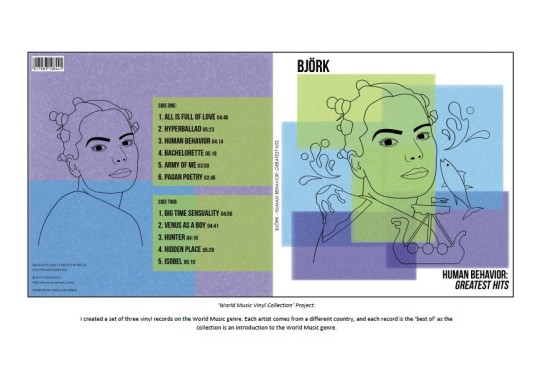
6.

7.

Action Plan - Review from Week 9:
After stating that I will apply for internships, I have applied for 3 different opportunities using my new, re-fined CV as well as the portfolio I’ve created. The internships I’ve applied for are all directly graphic designer based - those are Graphic Designer and Digital Marketing Intern at Derbyshire Toy Libraries, Graphic Designer at TwoGuys Creative and Graphic Design Intern at Akoma. After a week or so, I’ve found out I’ve also been really successful and got interviews for all of them:



I am really pleased with this outcome, and I think this is due to the visit paid to the Careers & Employment who helped me to write a good CV and a portfolio. I will now attempt at preparing for those interviews - this includes printing out a physical copy of my portfolio, thinking about what I want to say when asked the general questions such as why do you want to work for this company and making great first impressions overall.
0 notes
Text
Week 10 - Group Project Carries On
The first group meeting since the pitch happened on 3rd April. This time, Tom turned up as he decided to contribute after the discussion of potentially removing him from the group a couple of weeks back. However, the group wasn’t complete as Karolina was missing for reasons unknown. We set Tom the task of choosing a font which can be applied to all of our drawings as a way to contribute to the group work, and this is what the meeting was prominently about. Unfortunately, due to missing all of the other meetings, the fonts Tom picked weren’t what we discussed weeks ago as we decided we wanted a bold, clear, simple font, and it wasn’t what Tom picked, so in result we found it hard a font we liked. In the end, we settled for Coolvetica as this was the best font out of the ones chosen by Tom. A little bit about Coolvetica, taken from DaFont.com (https://www.dafont.com/coolvetica.font) - Coolvetica is a scratch built, sans serif font, based on an American chain store logos circa 1970. This was an era where everyone was modifying Helvetica. Coolvetica recreates that 1970s custom display lettering look with really tight kerning and funky curls. The tails on the R and a have been left out to allow even tighter spacing. It’s a pure display font, intended for big, funky headings and titles. I think the fact that the information states that the font is intended for big headings and titles is what makes this font work - we know that when the images will be enlarged and placed on walls, the text will still be clear and readable.
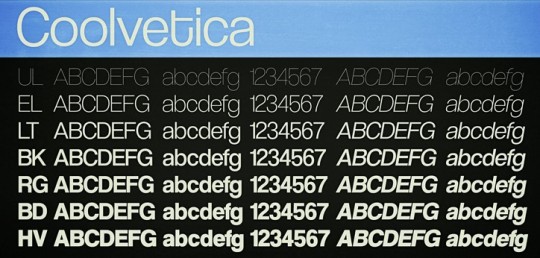
Next, we discussed the feedback given to us during after the pitch, which was making the imagery more consistent so it looks like it’s a part of the same series whilst still showing off our individual styles, and the explanation as to why those quotes are there and about the person who the quote comes from. To address this, we will create the following elements: a booklet giving background information on the person who the quote comes from, why the quote is relevant and important and how it relates to current events and the university. This booklet would be placed beside every quote, so people would take time to learn about the person and the issue they are raising awareness of. On the end page of the booklet, there would be a QR code that can be scanned which would then link to a video. So, the second thing is a link to a video of the activist giving a talk about who they are and what they do. Lastly, we want to create a website that can accessed by a QR code, that is a space for the audience to tell about activists they find inspirational and important, and explain those in detail.
The following elements will be created through splitting tasks; I have chosen to design the website (just a screenshot of the homepage), Alison and Anniko will be researching into QR codes and Georgia is going to create a sample booklet (only one is needed as each booklet has the same look and style). As Karolina was missing, we have decided to not set any additional tasks for her as there also weren’t any that needed doing, whilst Tom has decided to create his own image and pick out a quote as he has now chosen a font. After all these are created and final, we will each edit the final image onto a wall on the university’s Markeaton Street site and create a mock-up of what it would look like if it were real.
Update 12th April - I have now created my final outcome, coloured in using our guidelines, as well as with the Coolvetica font applied. I will now work on editing this image onto a blank wall on the Markeaton campus, making it seem as realistic as possible.

In addition, I have created the website which I was tasked with - I used a Wix website as a template, and only focused on the homepage which is the key feature of it - this is where the audience would be able to post their inspirations and activists they think are important. I have also made the decision that the ‘about’ part of the website would be used for more further information, e.g. the information about all activists in one place, as well as this is where the links to them talking about themselves and their work would be found. This is my website design, with sample text posts:

Action Plan - Review from Week 2:
Since the second blog where I started my Behance profile, I have visited it from time to time to upload some new pieces of work and to follow new people, as well as to check my notifications. I haven’t used it as much as I hoped to, as in all honesty I just wasn’t sure who to follow and felt quite intimated that most accounts I’ve come across have a large following and project views, so won’t bother to look at my account. I have used this blog article I found from CB Creative Bloq posted on 7th November 2012 titled “Top Ways to Get your Work Noticed on Behance” (https://www.creativebloq.com/career/get-your-work-noticed-behance-11121177) to try to build some type of following on my account. The article was quite useful; some of the tips to get the most of Behance were:
Highlight your work - You have to think of your projects as advertisements, and you’re selling you. Since you can't physically show visitors your work try to include enough detailed images to give them a sense of what it would be like to hold it in their hands.
Choose a cover image - When deciding on a cover image to represent your project, remember that it will be this image that entices the viewer to click on your work. In general it’s a good idea to stay away from using text in your cover images unless your project is about typography .Let the work speak for itself. Your cover image should leave your visitors wanting more.
Only publish when you are finished - You should only publish your project when it’s completely finished and you are completely happy with the final result. Once a project is published people will be able see it.
Create some buzz - Once your project has been published, try and create some buzz around it. Built into the “Public Project” section of your Behance portfolio is a ‘Promote Project’ button that will allow you to send out a notification about your project to Twitter, Facebook, and LinkedIn at the same time. Use these tools as well as other social media outlets such as personal blogs, Pinterest, or Tumblr to extend the visibility of your project to your friends and followers. Attracting project appreciations and comments can be another great way to get you noticed by the Behance curators.
I attempted to use those tips - I ensured I used tags underneath my work to attract more views as it would come up in searches, and double-checked my projects have close-up images where appropriate, and only ever uploaded completed work.
Currently, I have 13 followers and are following 15 accounts, some consisting of people I know as a couple of my fellow course mates are also on Behance and have even added me to a “UOD Graphic Design” group. Thanks to this group is why my project views are fairly high - it helped me get more exposure.
I will attempt to carry on building a following, even if it is gradual still and get my account to have more exposure by building up the number of views each project has - I think the views are more important than the following.
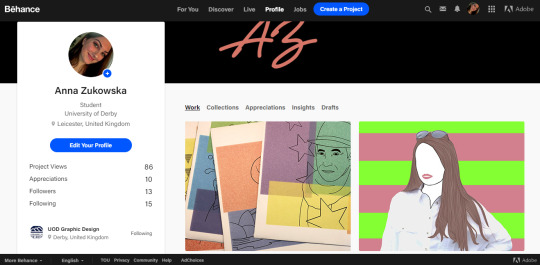
0 notes
Text
Week 9 - Self-Employment
The lecture on 26th of March was all about self-employment, with guest speakers Laura Williams, a commercial business services manager, and two University of Derby self-employed graduates; Pandora Johnson and Jodie Powell.
The lecture started off with defining what self-employment meant: a person is self-employed if they run their business for themselves and take responsibility for its success or failure (https://www.gov.uk/employment-status/selfemployed-contractor). Self-employment is very popular in the UK; in fact, it’s on the rise, and the number of self-employment increased from 3.3 million people (12.0% of the labour force) in 2001 to 4.8 million (15.1% of the labour force) in 2017 according to the statistics from the European Union (https://www.nwes.org.uk/blog/how-self-employment-is-changing-and-the-statistics-you-need-to-know/). The popular and best areas to be self-employed in include Graphic Design, Photography, Writing, Social Media Specialist and Make-Up and Beauty (https://www.indeed.com/career-advice/finding-a-job/best-self-employed-jobs). The creative sector is most popular for self-employment.
The lecture then moved on and focused on the support University of Derby gives to its students who are interested in self-employment and have an idea for their own business. Laura Williams was the first guest speaker, who explained all about the Be The Boss programme, the key element of that part of the lecture. The programme is described on the University of Derby website as “An award winning programme of enterprise support aimed at students and graduates of the University of Derby who want to become self-employed. Through a combination of action planning, one-to-one support provided by experienced business advisers, a series of workshops and other activities, you’ll be able to develop the skills you need to confidently set up and run your own new business”. As a summary, it’s a way to get help with starting up your own business as there is a lot of knowledge needed for doing this, such as knowing how to promote yourself and money management. I haven’t heard of Be The Boss previously, and wasn’t aware that the university gave this much support to anyone wanting to start their own business. However, I don’t think this is anything I will be participating in, as I don’t think I would be able to manage my own business and it simply doesn’t appeal to me. Williams then made us aware of Banks Mill Studios. As described on its website, “Banks Mill Studios is an innovation space for creative and digital industries, located in a landmark building within the heart of Derby City Centre. Comprising of 38 clean and dirty studios and a ground floor gallery, Banks Mill offers stepped rent over a period of six years along with vital business support services and a connected community of peers to ensure success at all levels of enterprise growth. We have a diverse range of creative industry disciplines within Banks Mill – from jewellery makers to printmakers, computer games to fine artists. Our residents and members are both University of Derby students and graduates, and creative entrepreneurs not connected with the University”. (https://www.banksmill.co.uk/)
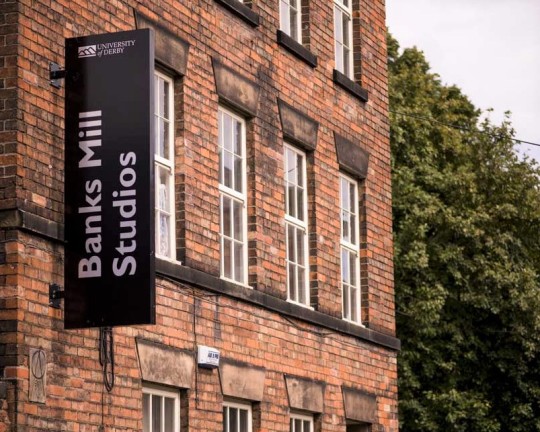
Banks Mill Studios, own photography
Banks Mill does not only offer studio space for a certain amount of money per month, they also offer support, from helping artists come up with business plans, to promotion through social media, and a chance for their work to be seen and potentially bought by hundreds of people who attend the exhibitions and open days that happen regularly. I found the information received about Banks Mill really useful as I have heard of it and walked past it many times, but didn’t think anything of it - I assumed it was only studio spaces for artists, and I wasn’t aware the support given and that the support can only be bought as a membership only too without the studio space.
Williams then introduced Pandora Johnson and Jodie Powell who are two designers based in Banks Mill Studios. Pandora Johnson is a website designer and developer, illustrator and a co-founder of Green Door Printmaking Studio, set up with the ethos that printmaking should be accessible to anyone who is interested in exploring and developing their own creative practise with print (https://www.greendoor-printmaking.co.uk/).

Some of Johnson’s work, taken from her Instagram page, including a self-portrait in the middle.
Johnson has always had a keen interest in printmaking, and said she set up her own printmaking studio as she realised that the printing studios at University of Derby’s Britannia Mill weren’t accessible after she would graduate. This resulted in her creating Green Door Printmaking Studio - Derby’s only open access printmaking studio. However, the studio isn’t only used for open access - there are courses and classes that can be used to learn different printmakng techniques, and the opportunity to work alongside Johnson, an experienced printmaker.
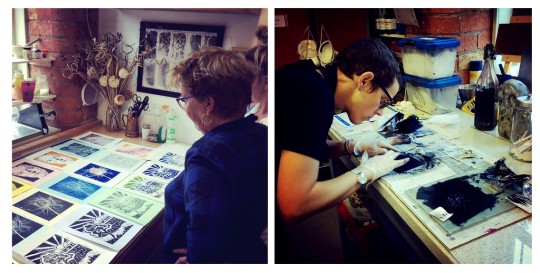
People working at Green Door Printmaking Studios, taken from Studios’ Instagram page.
Johnson is primarily the screen printing tutor a the studio, as well as taking care of the general day-to-day managerial duties of the studio environment. During the lecture, Johnson talked about her journey to getting to the point she’s at today; she’s always done creative, freelance jobs so has no experience of what it’s like working for someone. I found that interesting as it meant she clearly always knew she wanted to be in control of herself and her work. On the other hand, Jodie Powell’s journey was slightly different as she mentioned that to get herself through university and life after graduating she worked a retail job that wasn’t relevant to what she wanted to do.
Powell is a tattoo artist and graphic designer, and has her own tattoo studio at Banks Mill - Jodie Bambi Tattoo (https://en-gb.facebook.com/jodiebambitattoo/). During the final year of her Masters degree in Graphic Design and Visual Communication, Powell took on the role of a tattoo apprentice where she learnt about the equipment and health and safety aspects of this profession. Once she completed that, she started taking commissions and eventually got a lot of clients and business, meaning she could open up her own studio and quit her second retail job.
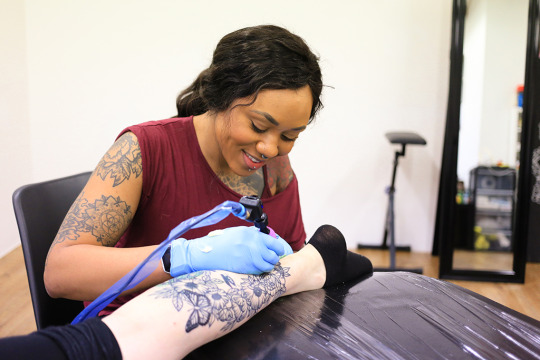

Some of Powell’s work, including a photo of herself, taken from her Instagram page and Banks Mill website.
Powell specialises in dot work and blackwork styles amongst other styles of tattooing, including semi permanent eyebrow tattooing. She enjoys ornamental, floral and geometric styles. She said she spends most of her time - about 70% - creating designs and actually tattooing, whilst the other time - about 30% - is spent replying to emails and admin tasks. She said that she finds her freedom important and doesn’t like to be controlled and told what to wear, how to act, etc, which is why being a freelance designer suits her perfectly.
The lecture ended with a Q&A between the guest speakers with questions from the audience such as how does being a freelance designer works, how many hours do you work, what to do when you don’t have steady business, etc. I found the talk insightful because the guest speakers were University of Derby graduates, so it’s interesting to see what life after graduation looks like, especially when choosing the self-employed path. Despite finding the lecture insightful and useful, I don’t think self-employment is something that’s right for me as I always imagined myself working in a studio with others - perhaps after experiencing this, maybe it’s something I will consider - really far in the future though.
Action Plan - Review from Week 3:
I stated a couple of week’s ago that I think I would benefit from having an appointment with the Careers and Employment, to discuss what the next steps for me are in order to achieve the career I want. I had this appointment on the 26th of March with Marian Derbyshire.
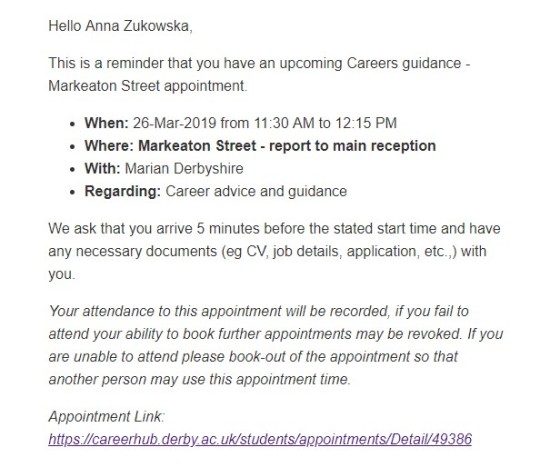
During the visit, I got asked to think about I see my career looking like, and how to get there. First, Marian asked me about why I’m at university in the first place, which I replied to that in order to be a successful graphic designer I need a degree as most jobs in that field require it, and it will help me have the necessary knowledge and practice. We then looked at what would my ideal job would be – this really helped me think about what I really want out of a job and the type of conditions I want to work in. I stated that my ideal job would be 60% individual work and 40% team work but I don’t mind if it’s 50/50 between each. I also want a friendly environment, a routine so coming in at the same time, working in the same studio etc but working on different projects so there’s variety, creating designs I can use in my portfolio later, and working on marketing and branding projects. Now Marian knew this, we have discussed the job market, and how about 30% of it is what is advertised online, in papers and such and the rest is through networking and contacts. I then told Marian that I have done some networking so far – talked to designers online, met up with one in person and visited a studio to which she complemented me on and said I was going along the right lines, and just need to find a way to make those contacts last.
The next part involved me getting my CV checked – specifically for this meeting, I have written a fresh CV that’s Graphic Design based as I only had a general one which was used to apply for retail and customer service jobs; the field my part-time job is in currently. I received advice on how to improve that CV and that I should alter it to each specific job I apply for as each job demands different skills, experience etc. We then visited the Careers and Employment website and the ‘Live Jobs’ section, where current jobs are advertised. Marian suggested as a way to get experience, I should apply for the internships I think I’m suitable for, which I also think is a good idea as the experience would really benefit me in the future when I am applying for graduate jobs – it’s something that will make me stand out.
The meeting ended with Marian reflecting on what we discussed, and emphasising that I’m very determined to get professional experience and are always thinking about how my current projects can benefit me - portfolio wise, or experience wise such as working in a team. Following Marian’s advice, I will go back to the ‘Live Jobs’ section of Careers and Employment website and apply for some internships at some point during the next 2 weeks or so.

0 notes
Text
Week 8 - Group Project Pitch
The preparation for the group pitch on 22nd March took place a couple of weeks beforehand. Once the style of artwork was decided on and ideas created, me, Alison and Anniko met up to discuss the content of the presentation as well as to present the final ideas we want to develop. After a productive meeting, we came up with the following list of what we want to cover in the pitch, and sent those on our group chat to catch up the members who weren’t available to attend the meeting:

The presentation PowerPoint was created by Alison, with the help of everyone who sent in their content. I proofread the PowerPoint once it was completed and made any necessary changes, which weren’t many. The finished PowerPoint can be viewed here: https://drive.google.com/open?id=1NPGDdb-VBDIASNLx1XiVrJMBzl4e_kbd. We decided on having three speakers instead of having everyone speak to make the pitch run more smoothly – those three speakers included myself, Georgia and Alison. Anniko was allocated to change the slides to match what we were saying, whilst Karolina came to support and help to answer any questions that were asked at the end.

The script used during the presentation - my parts were in blue.
Unfortunately, Tom wasn’t at the presentation and so far and hasn’t contributed in anything we have produced so far – no ideas or sketches as well as not turning up to any of the group meetings outside of scheduled lesson time or replying in the group chat used in between meetings, so the question of keeping him came up at the end of our pitch. We felt that it was harsh to completely remove Tom as the group project was only halfway through, so instead we decided on trying to contact Tom to give him another chance to contribute. However if that were to fail, we will have to ultimately remove him as he isn’t putting in an effort to take part.
The feedback received from the tutors was positive, with only a few improvements that included having some kind of feature that makes the quotes and theme consistent, so something that makes it obvious that the quotes are all a part of the same ‘collection’. Additionally, the interactive element we briefly outlined is something that was encouraged for further development; the idea of having a QR code to scan to show a video of the activist was really liked. We also received positive comments about the originality of our idea and not going for the obvious images of birds and birdhouses, and a suggestion to take on board was to find a way to engage the audience and make them think about activists they found important and inspiring. This again could be done through the use of QR code scanning, or perhaps a wall display could be created with the contribution of people who want to tell others about their inspirations.

Contract signed by present members, along with a statement of what we want to achieve.

The group, from left to right: Anniko, Anna (me), Georgia, Alison and Karolina.
I think the pitch went really well as everyone contributed something to it; we will take on board the feedback and suggestions made to us, as well as trying to contact Tom and try to decide what the appropriate action to take next about his situation is.
Action Plan - Review from Week 7:
In the last blog post, I have stated that I was given a lot of useful portfolio advice from the designer I met up with, which I want to follow up on by researching further into what makes a good portfolio. I have looked at two articles; the first one is titled Top Creatives’ Advice for Grads on Putting Together a Portfolio (9th July 2015) on It’s Nice That which is an online platform full of advice, articles and news from Graphic Design, Illustration and Animation worlds. The article can be found here: https://www.itsnicethat.com/articles/graduates-advice-portfolios. The article is aimed at graduates, straight out of university and advises them on how to put together a successful portfolios in order to get noticed and ultimately get the job. The following is a list of things that will ensure your portfolio is a success, in note form so only the key information is included:
Length – Less is more; you have to make touch choices about which pieces of work to include, don’t repeat yourself by including similar pieces of work, show a variety, don’t put in work you aren’t proud of.
Quality – Don’t put in work that you can make better; make it better, then put the work in. When including school projects make sure they feel ‘real’ and look professional.
Tailor to your audience – You have to think about your audience and how you want them to feel when they see your work and what you want them to take away from it. Don’t try to impersonate the style of the artist / studio you’re applying for, and show what you are interested and passionate about developing not what you think people want to see.
Can you talk about it? – Portfolios need to serve as tools to facilitate a conversation when you’re meeting a potential client or employer face to face, otherwise they’re useless, Make sure it enables you to talk about your work so create pages that you easily can talk about, and that can then spark a conversation.
Presentation - Consider not just the work but how also it’s presented, from the type to layout, make sure your portfolio shows an aesthetic that is true to the work you want to create, and also feels original enough to hold the attention of your potential clients. If you get stuck, look at how your favourite magazines progress through interesting layouts and take this into account when designing your own portfolio, the most important thing to remember is it should speak about your interests and define you as an individual artist.
Practical advice - They can go missing, so with a physical portfolio, remember to label it clearly with your name and address. Don’t include your CV.
The second article I’ve looked at appeared on the Lifewire website, which is a well known technology information and advice website. The article I’ve looked at is titled Graphic Design Portfolio Projects (3rd November 2018) and it states what kind of projects to include in your portfolio. The article can be found here: https://www.lifewire.com/graphic-design-portfolio-projects-1078707. This article is extremely useful to me as recommends what is needed in a portfolio when you have little real-world experience and no clients, which is where I am at right now. It lists the following projects, again in note form:
Web Design - In addition to including samples of any live web pages you worked on, include individual elements such as logos, navigation buttons or animations.
Logo Work - Include completed logos and the variations you went through to arrive at the completed version if you have them. Also, hypothetical redesigns of a well-known existing logo can show off your imagination and style.
Print Designs - These are "traditional" portfolio content, those projects designed for print. Even if you don't plan to work in paper on ink, the designs show your strengths and approaches to design.
Business Cards - Start small and design your own business card or redesign an existing company's card.
Brochure - Ubiquitous letter-fold, three-panel brochure is often the star of a print portfolio because you have to know where the folds fall and how to adjust the positioning of the text to accommodate those folds.
Packaging - Packaging design shows off your design skills and your ability to visualize the special requirements for a piece that requires intricate folding before delivery; you have to take into account the folds and the glue areas.
Poster / flyer - Even if you have to include a reduced version of a poster, include a poster or flyer. Your portfolio is a conversation starter, so be prepared to answer questions about how you designed the samples in your portfolio.
Lastly what I’ve looked at are some examples of graduate graphic design portfolios on the Digital Arts Blog website, which can be viewed here: http://blog.fidmdigitalarts.com/blog/14-fresh-graphic-design-portfolios-from-recent-fidm-graduates/. These are portfolios by recent graduates from Fashion Institute of Design & Merchandising Graphic Design programme, which is all about preparing students for future careers in Graphic Design within the apparel and entertainment industries. These are the examples shown that have really caught my eye:

This is a magazine cover and inside content created by Carrie Rooney. I really like this due to the consistent colour scheme that isn’t only found on the front cover, but also in the article. It creates a really professional feel.

This is the second example that caught my attention. I like the use of what the work would look like if it was real and accessed on a computer, or what it would look like appearing on a bus stop advert. This again makes the work feel real and professional, and shows an understanding of different formats.
All this has inspired me to attempt to create my own portfolio, ready to use in case any opportunities come up. I will use this research as a way to ensure that I am putting in the right content in my portfolio, which is key to get noticed by employers.
0 notes
Text
Week 7 - Practitioner Meet Up
I have originally planned on visiting a studio, as this is the type of environment I would ideally like to work in after graduating at university, so seeing what one works like would be a good experience. Unfortunately, trying to visit a studio for even a maximum of 20 minutes had proven to be very difficult and I didn’t receive many responses from studios willing to let me come visit due to them being very busy. I have decided to instead look into freelance and individual designers as a contrast to studio work – I have received some responses this time, and the work of one artist in particular caught my eye. After a week or so of planning, I have met up with a local Derby graphic designer on the 14th March.

The designer was Kieran Harrod, an independent Creative Director and Graphic Designer, practicing design since 1999 – his website can be viewed here: https://derby.graphics/. Kieran was very modest and very polite all throughout our meeting; we have met at Rask on Sadler Gate, a coffee shop right next to Sadler Gate studios where Kieran can be found every Thursday using the studio space.

Sadler Gate Studios, Bauman Lyons photography.
The meeting consisted of me asking questions I have prepared, and a general chat and advice at the end. I have started by asking Kieran about his background and how he got into the industry:
How did you get into the industry?
“I have studied design at Chesterfield College late 80s; at that time, Chesterfield College was the place in Derbyshire to study design. I have then got into University of Staffordshire to study Multimedia Graphic Design, however I wasn’t exactly happy with my experience as I found my lecturers not very helpful or useful. I then worked a couple of jobs, and then had a breakthrough working at UMC Group Ltd as a Mac Operator, designing brochures, websites, banners, posters and exhibitions as part of a small in house marketing team. After about 2 years, I got promoted to a Marketing Manager, managing three other team members and gaining new responsibilities. After that, I was a Writer for LogoCurious.us, which is a collection of images, links and articles relating to logo design and branding - it's a collection of my thoughts on logo design from around the world. After this, I became a freelance designer due to starting a family as I wanted something more flexible and to fit my schedule around theirs.”
Can you tell me more about being a freelance designer?
“Before deciding to go independent, I have created a business place which I learnt about on a course I did – “Expanding Enterprise” – which looked at finances, cash flow, taxes etc. They made me calculate how much I need to earn, my cost and made me also think about how I would go about getting my business. I have a website which is my main platform to get business – half of my clients come from this, whilst the rest are word of a mouth and a good reputation. Getting your name out there is so important, and a good reputation really helps that. I find that I have more responsibilities being a freelance designer in comparison to when I worked in house – I have to arrange meetings, market and promote myself, invoicing and the actual work itself. When I have the time, I do school visits to try to get them to be interested in graphic design as well as doing visits like this one with you today – this is something I wouldn’t have been able to do if I weren’t freelance. So I’d say freelance has definitely much more flexibility, however the pay isn’t constant so that’s a big factor to consider when going freelance.”
How do you go about designing something as a freelance designer?
“I always start off my researching the company I am working for and create an aesthetic I want to work with based on that research. The research can either be through the company’s website or I will call them up and ask them to tell me more about the company that way. I then start to think about design – I never Google already existing logos as I want to create something unique, and I don’t like being literal in my design. I design using my style of geometric shapes and modernist influences; I’m not very illustrative. I then create a couple of mock-ups, and it goes from there – depends on how much the client has paid what I do next”.
Do you have constant business / work flow?
“I only do work that’s worth my time and the money in all honesty. Many of my customers come back, so I have regulars who require new designs. I have a good relationship with them – they respect my opinion when it comes to design, and in return I give them my time and an outcome that they are satisfied with.”
Do you mainly work digitally or do anything by hand?
“I always start any ideas by sketching. I also sketch when I can when I’m out and about – I carry my bullet journal on me always as I also take notes there too of things I have to do as a reminder.”
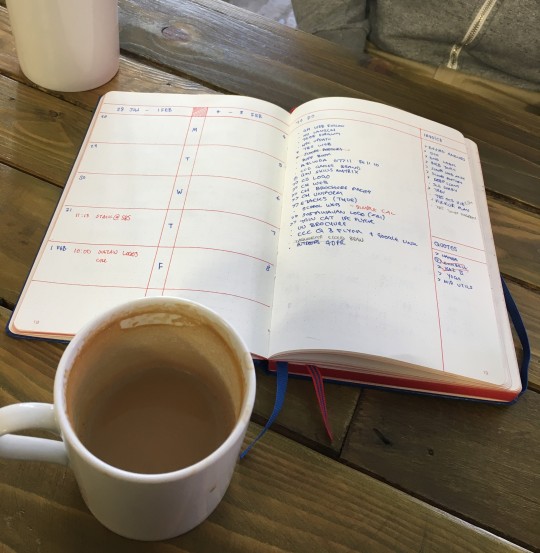
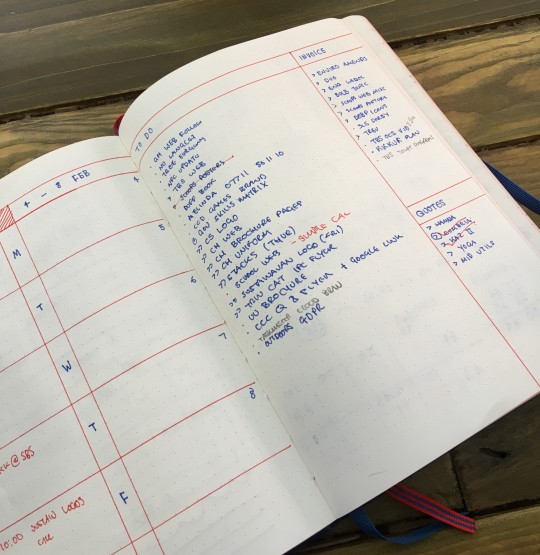

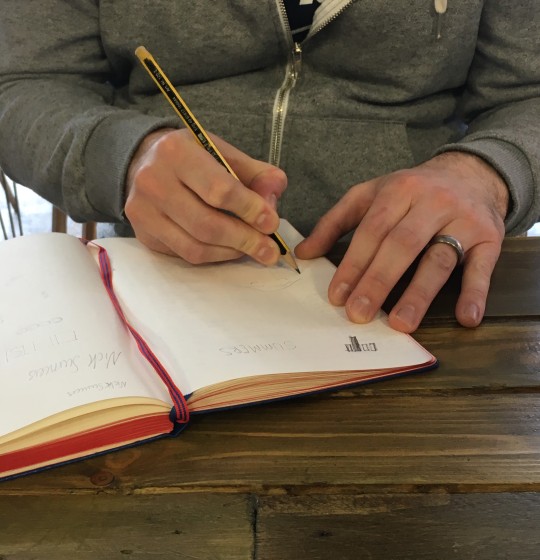
Kieran has then shown me his current bullet journal and the rough sketches and ideas in it.
Do you mainly work with Derby based companies?
“Mostly yes, but I do work all around Derbyshire, as well as having worked with companies from Nottinghamshire and Staffordshire previously too. It’s easier if a company is quite local as I like to meet up in person to talk ideas out with the customer and I can become valuable to them this way as they can see me as an expert on all things design.”
Do you keep in touch with the design community in Derby?
“A little bit in all honesty – I don’t think I network as much as I should. I talk to the designers who I share the studio space with – when I work at Sadler Gate studios, I get to socialise with many designers as the studios are so busy; it’s a hub of creative people. You really do get results from networking though, so perhaps this is one of my goals for the future – to network more.”
What do you do when you’re not designing?
“I mainly focus on my family as I have four children. We enjoy playing with Lego together and watching things about Lego on YouTube. I also love board games, and encourage my kids to play too. I am a keen podcast and radio listener too.”
What is your favourite project you’ve worked on?
“Skyeland Soft Play Logo & Branding project I worked on (the full project can be viewed here: https://derby.graphics/portfolio_page/skyeland-soft-play-logo-branding/).

However, I didn’t charge enough for the amount of work I’ve produced for them! The company came to me with a firm idea, like most companies do, which I followed but gave my own insight to achieve the final logo.”
What are you currently working on, if anything?
“I am currently working with Corporate Hire company from Derby who are all about hiring audio and visual equipment. I am creating branding for them, which is what I like – I prefer creating a whole branding identity, instead of just a logo as I like getting to know the brand. I am also creating artwork for a DJ, based in Derby again, that would go on Spotify and iTunes, a brochure for an embroidery business, and branding for a security company. I normally have multiple projects to work on rather than just one, and I prioritise my customers based on the money they paid as different amount of money gets different attention I pay to the customer.”
What are your plans for the next couple of years, if any?
“I’ve been freelance for years now and my biggest stress is time, so to solve this I have been thinking about expanding and hiring more staff to work alongside me but this would require starting from scratch again as I would have to create a whole new studio, and even company perhaps. However, I would need more money for this so either getting more business or charging more, which isn’t exactly what I want to do though. This is an idea for when my kids grow up more and start high school, so maybe in like 4 or 5 years.”
Are you satisfied with your business?
“Yes – I am very lucky I get to design everyday as it’s something I love. I don’t like the invoicing, tax etc side of it, but apart from that I love everything else. It can be difficult money wise sometimes when I have no business or don’t get paid much, however those are rare. The work hours vary which I like again as it’s exciting and never dull.”
After about an hour of me finding out about Kieran’s work and being a freelance designer in general, we had a general chat about design and Kieran was keen on finding more about my design and university experience so projects I’ve worked on, currently am working on and what I want to do in the next couple of years. This led to Kieran giving me loads of tips and advice on putting a portfolio, as he himself has hired people before and judged many portfolios:
Include around 6 really good pieces of work you are happy with
This work has to make you stand out – so don’t include projects that are very common, such as album covers
Make the effort to meet the person hiring or visiting the company in person as it makes a very good impression – shows that you care, and your work will definitely be looked at
Show a variety of work if you consider yourself versatile
Be accurate always – no spelling errors, bad quality prints etc.
When I voiced my concern about not having much work I actually want to include in my portfolio, Kieran suggested I should look at briefs online or do some branding for a charity to boost my portfolio – he strongly said not to do fake briefs, as those simply don’t work as your work isn’t ‘real’.
After about an hour and a half at Rask, Kieran invited me to Sadler Gate studios, for a quick visit to see what the workspace looked like – the workspace was made up of one room, with a large window, a desk in the middle of the room and a book shelf on the other side. It was really spacious, clear and neat.
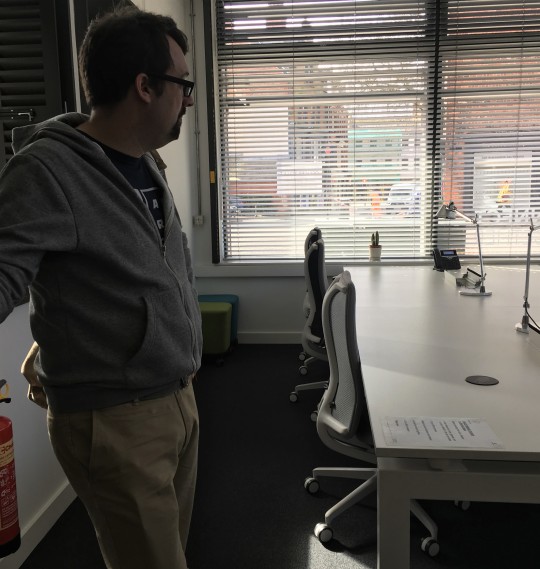
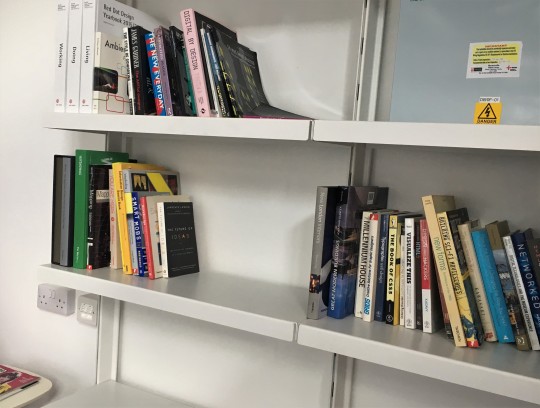
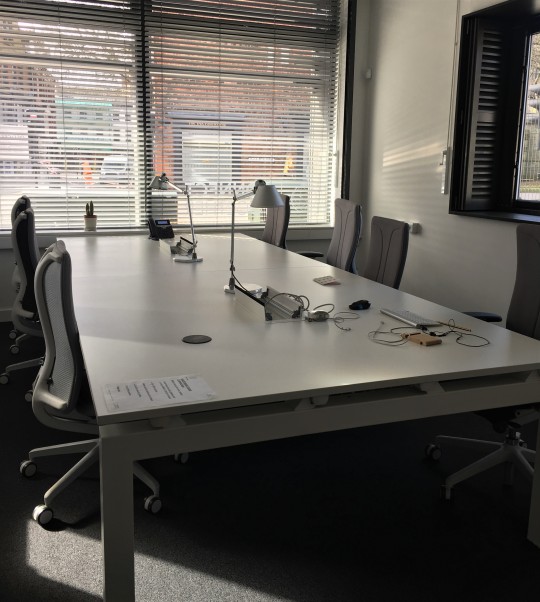

This meet up was really useful to me as I now understand what being a freelance designer is looks like, and that it is actually more than just about having more free time, being flexible and only designing – there are many more responsibilities included as you are managing yourself.
Action Plan:
The portfolio advice has inspired me to research what makes a strong portfolio, and what I would need to show if I were to make one to go into my preferred areas of Graphic Design – so branding and editorial. This will be really useful to know as this is vital when applying for jobs.
0 notes
Text
Week 6 - Group Project: Start and Progress
The group project started on 8th of February when we got set the brief and found out our groups in the lecture. This is my group, in photo order: me, Tom, Alison, Anniko (team leader), Georgia and Karolina. I’ve actually worked with most of these group members before apart from Anniko, who’s an exchange student, as we are all on the same course; specifically, I’ve worked with Alison on multiple projects so I was quite pleased to find out we’re working together as we work really well.

After the initial brief, which is to create imagery to go on plain and uninteresting areas of the Markeaton Street campus on the theme of ‘birdhouse’, the groups had a chance to sit down and get to know each other. Although we all knew each other already, we haven’t had the pleasure of meeting Anniko so we used the sample questions, such as what is your happiest memory, what is your favourite place, your most embarrassing memory, etc., as a way for her to get to know everyone and for us to get to know her. After the chat and laughs, we decided to explore the campus and look for areas which would be ideal for the project. These are some I photographed:


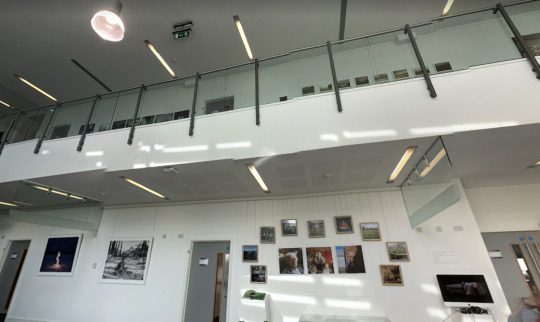

The first and last photos were areas which in particular caught my eye; they are both areas many people use as a walkway, and as there aren’t any classrooms there I thought they would be good to use.
After exploring the campus, we have made the decision to mindmap individually throughout the week about what the word ‘birdhouse’ meant to us personally. This is what I came up with - a mix of sketches and mindmaps. I have split the words ‘bird’ and ‘house’ up and thought about the associations of each word. The sketches reflected on the mindmap, and helped me visualise the words and how the ideas can be taken further.

On the 5th March we had arranged a group meeting, and me, Alison, Anniko and Karolina attended; Tom didn’t attend and didn’t say why, and Georgia had to commute so she chose not to attend and instead share her thoughts through a Facebook group chat we created. During the meeting, we all shared our thoughts, coming up with the following associations of the word ‘birdhouse’, and have created a mindmap together:
Charity – living in a house provided by someone else
Safety – a place to call home
Family – where life begins
Building and labor
Freedom – can leave and come back as they like
Designed to lure a specific target

From this, we were inspired by the word freedom the most and the connotations of it, and how birds specifically relate to this theme too. Again, we made another list, but this time thinking about the associations of the word ‘freedom’:
Movement
Speech
Human rights
Happiness
Being able to do anything
Be yourself
Acceptance
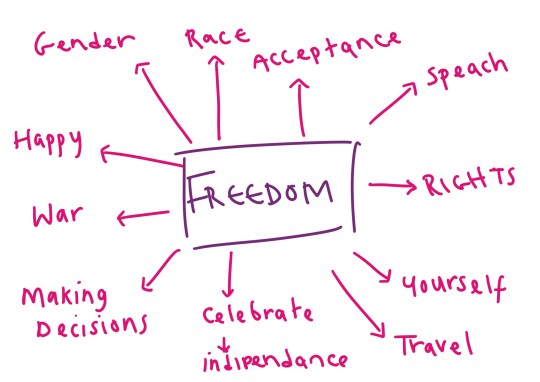
The initial idea then happened - we have associated freedom with activism; perhaps placing quotes on a staircase from inspirational young activists would be an interesting take. The interactive side of it would be that if a code or something like that were to be scanned, a video of where said quote came from would come up. We have each researched different young activists, using these websites as help: https://www.complex.com/life/young-activists-who-are-changing-the-world/?fbclid=IwAR01ONZAq4ZH6TrbvEylg3YOWlS6kvJKY3E8MnM59xMMTrvsjkWbMrTsFfM (Complex magazine) and https://www.theguardian.com/society/2018/may/13/young-people-are-angry-meet-the-teenage-activists-shaping-our-future?fbclid=IwAR0M76QvULiMY3rH9bn8DzcKjAudPcDsNFSse8kLRBJMrTSwBpDShke40L8 (The Guardian newspaper). However, after this, we decided to make it broader and focus on important activists in general. Individually again, we all planned to choose an activist and create some ideas and sketches based on them and their work. I have still decided to focus on someone I found in both these links; Xiuhtezcatl Roske-Martinez, who has been working in climate change activism all his life. I’ve picked Martinez as he focuses on fighting climate change which is such an important topic currently, and definitely something that relates to university students who are young and have the potential to create the change needed.

From this research, I did quick illustrations of objects associated with climate change, so nature, extreme weather, recycling, Earth and power plants:

These are some of the sketches I have came up with and presented in our next group meeting on the 12th March, attended by me, Alison and Anniko. They are all based on one quote which summarises the work of Martinez - I have decided instead of sketching, carry on doing some rough illustrations digitally as I’m also working with a large amount of text so it makes it easier to do so.




After discussion, we have decided that the images should relate to the quote, rather than being a portrait of the person as it’s clearer what the quote means with illustrations to go along with it. We have also decided that all of our artworks should look the same, to create consistency. These are the following guidelines we decided on together and wish to apply to our artworks: the same font (not decided yet), drawing relates to the quote, white / transparent background and no black outlines on the images. This is the style of artwork, created by another team member we want to use:

This is the idea I have decided to use as the final; this is just the sketch, as the final will be created after the presentation on 22nd March - the idea uses a simple contrast; the bright colours on the right hand side represent the world after the ‘great decisions’ have been made, whilst the black and dull side on the left represents the world now that Martinez is trying to change by preaching that we have the freedom and choice to do so.

Action Plan - Review from Week 3:
In the blog post that reviews the industry by looking at different articles, awards and organisations, I have said that I haven’t got any work I want to include in my portfolio that is editorial and this was an issue as this is an area I am really interested in. I have decided to re-style L’Officiel USA magazine; specifically, the first issue featuring Lana Del Rey being interviewed by her contemporaries, collaborators and friends (https://www.lofficielusa.com/music/lana-del-rey-cover-story#image-7486). I’ve chosen this particular issue because it’s the first issue published by the magazine, so a significant one, and I also like the photographs used. I have re-designed the front cover, and the magazine spread which focuses on the Del Rey interview. I have decided to add doodle style illustrations on top of photos; the doodles are simply white, to keep the sophisticated style of the magazine.

(The quality has been reduced due to the maximum capacity this website can handle. The full spread can be seen in person if requested.)
0 notes
Text
Week 5 - Manchester: A Cultural Visit
I have visited Manchester Whitworth Gallery on the 1st of March, as well as visiting Manchester Art Gallery and the Museum of Manchester in that day, however the Whitworth was the main focus of the day. The gallery is located in Whitworth Park and is part of the University of Manchester. It contains about 55,000 items in its collection - more information about the gallery can be found on their official website: http://www.whitworth.manchester.ac.uk/.

The gallery from outside, own photography.
The word I would use to describe the gallery is decorative as when you first walk in and start to explore, you see that a lot of the walls are colourful, lively, exciting and covered in bold, fun patterns. There were multiple exhibitions open, which regularly change, giving various artists recognition. The room I enjoyed the most is the wallpaper exhibition, Bodies of Colour - http://documents.manchester.ac.uk/display.aspx?DocID=37030. The exhibition celebrates all types of wallpaper, and the history behind it. The images on wallpapers in this exhibition come from ancient myths, pop stars, novels, toys, film genres, ‘exotic’ objects, news stories, art and cartoon characters. These were some of the wallpapers featured, but the ones I liked the most are the bottom two:





The first wallpaper I like was created by Virgil Marti (http://www.virgilmarti.com/). Marti creates hybrid objects informed by a wide range of art-historical and pop-cultural references. He’s known for inserting high décor into fine art contexts - his installations are rich in humour and shrewd observation. The wallpaper that is on display at The Whitworth is quite unusual – it consists of yearbook portraits of Marti’s high school bullies, hence the name of the artwork Bullies (http://www.virgilmarti.com/work/bullies/). The artwork is hand screen-printed wallpaper with fluorescent inks and rayon flock on Tyvek. The colours are very vibrant, bold and clearly inspired by the 70s. The images of the men are black and white with shades of orange, yellow and pink painted over them. They are positioned in a decorative, detailed border, and this border is placed on top of flower background. There is a variation of flowers, and those are a darker colour than the colour scheme of the frame. I think Marti used the flowers, a decorative border and colours such as pink, red and orange to portray a feminine mood, which would humiliate the bullies as they were all men who most likely have bullied to appear masculine, tough and manly. There only aren’t themes of high school, bullying and teenagers, but also stereotypes and gender.
The second wallpaper I liked was created by the French artist Niki de Saint Phalle (http://www.artnet.com/artists/niki-de-saint-phalle/). The wallpaper consists of a famous figure in Saint Phalle’s work, Nana. She created numerous Nana figures, often sculptures. Nana is said to be a joyous, black and voluptuous character, often interpreted as an expression of rebellion from the cult of female beauty. A variation of Nana figures can be seen here: http://www.dailyartmagazine.com/niki-de-saint-phalle-nana-statues/. The wallpaper seen at The Whitworth is fun and energetic. It consists of a large female character, surrounded by a slightly smaller one, a snake, a telephone, a key, a love heart, a hand, a sun and flowers. All these are very colourful and abstract. This wallpaper has a Surrealist feel to it, as none of the objects drawn are realistic in contrast to the first wallpaper. Something this wallpaper does share with the first one is the theme of gender: this wallpaper is very feminine, with the use of pink, love hearts and a female character who’s carefree and joyful.
I’ve chosen both of these wallpapers as they both had something about them I felt attracted to: with Saint Phalle’s work, I felt that I could identify with the Nana character as I felt carefree when I was looking at the artwork, and I immediately identified the feminine atmosphere and felt that the artwork was a celebration of femininity. With the second artwork, I was attracted to the colour scheme – I love the boldness of it and the contrast between those colours and the black and white images.
What I also really liked about the wallpaper exhibition is a table that was full of patterns, where the visitors were encouraged to create a rubbing, taken from the table. I have created a couple myself, see below:

I found this visit inspiring as I have never thought about wallpapers being artworks before, and to see such a versatile collection was so interesting and exciting.
Action Plan - Review from Week 1:
In the first blog post I have stated that I wanted to use some of my skills such as drawing, painting and printmaking in my future university work. I have done this in my recent university project – I have created a screen print background that was used on my vinyl front and back covers. The screen prints consisted of the same shape, which was a simple square, however those squares were then overlaid with others to create the background. The colours used represented the country of each artist as all artists came from different countries. I have scanned the screen prints in, to enable me to achieve new colours through editing on Photoshop, ensuring at the same time none of the authentic screen print texture was lost. These are the front covers I have created:

The full collection can be seen on my Behance profile: https://www.behance.net/gallery/77044329/World-Music-Vinyls
0 notes
Text
Week 4 - Guest Speakers
Over a course of two weeks, we had the pleasure of welcoming different guest speakers, coming from graphic design, illustration and animation backgrounds. It was a great experience as I haven’t had the opportunity to attend a talk from a professional designer, nevermind three different ones from various industries.
The first guest speaker that came to the university was Korky Paul, an award-winning illustrator of children’s books, most famous for his work for the Winnie The Witch books. These are books I owned and loved when I was younger, so I was really excited to meet the illustrator behind them! The Winnie The Witch books are worked on with Valerie Thomas, who writes the text – the two don’t have a personal relationship, despite collaborating on many books together as all the work between the two is done through their editors and agents; I found this particularly interesting, as I thought authors and illustrators often worked closely together.
The talked consisted of Paul giving an insight to his work process, describing in detail how he starts an illustration, right until the finished product. Paul creates his work with bright watercolour paints and pen and ink; his work is recognisable by an anarchic yet detailed style. Each illustration take roughly five days to complete due to the detail; in a standard 32 page picture book layout, which Paul described, there are about 24 pages of illustration as the other pages are used for titles, copyright text etc – this information was extremely useful, as now, if I were to create my own picture book, I would know the layout and what each page consists of. Typically, the illustrations Paul creates are over a double page spread, so he creates 12. As a starting point, Paul researches the object he is going to draw. In this case, the process he described came from Winnie’s Dinosaur Day book – the key subject is dinosaurs, so Paul looked at images of dinosaurs, their habitats and behaviour. He noted that he was surprised that no one really knows what colour dinosaurs really were, which gave him the freedom to paint them any colour he wanted; he normally creates quite realistic work, as stated earlier, so being able to pick any colour to work with was exciting. After this, Paul studies the text he has been given; he strongly pointed out that there must be a connection between the text and images as the Winnie The Witch books are children books, and the images exist to help them understand the text, which is why they must reflect the text. A first rough draft of a drawing that is inspired by the text is created. Paul doesn’t simply create this on a clean sheet - he considers the layout of the book, so the text has its own space, enabling it to stand out, and not be covered by images. He also considers bleed and trim when it comes to printing, so he isn’t drawing on edges that will be cut off.

The first rough draft (image belongs to Korky Paul)
After the first draft of the drawing is created, he uses a photocopier to enlarge the drawing to the correct print size, and places this on a lightbox, a vital tool when it comes to illustrating considering to him, making it easier for him to copy what he’s already drawn. The drawing is the improved by fixing composition, design and text positioning. Inks, specifically Kanadahar drawing inks and a dip pen, are used to draw over the pencil lines, and those are then erased. The photocopier is then again used – this time to copy the drawing onto watercolour paper. Again, pencil lines are drawn over with same inks, then erased. Before using watercolours, masking fluid is used as a base, then peeled off. Then, the painting beings – Paul uses Schminke Horadam Aquarelle watercolours. He starts by painting the background, then midground, and foreground last.

Painting progress, and finished painting (image belong to Korky Paul)
All the finished drawings are lastly scanned into his Mac, where he uses InDesign to place them into a document which is then sent to his editors.
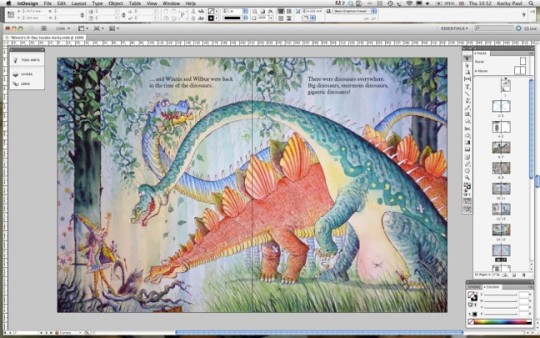
Images placed in InDesign (image belongs to Korky Paul)
During the talk, Paul shared his drawings of all the illustrations he had done for this book, and we were able to see the in person the rough drafts, outlined images and the finished ones - this was really inspiring as it was a different experience getting to look at it in person and seeing all the detail close-up, rather than just what was being shown in the presentation. I took some images of the outlined images; I got given page 24 and 25 to look at, which again was interesting as I got to see what the other illustrations in the same book were like.


The second guest speaker was a former University of Derby student, Ian Cherry. Cherry has passion for sports, especially football, and this is what he focuses his graphic design work on as he specialises in designing typefaces that are used on back of football shirts. He currently works at the Derby County Football Club, and has an impressive history of designing for clubs like Real Madrid, Manchester United and Hull City. Cherry’s talk consisted of his journey from leaving university to now, which was really interesting and inspiring as it was relatable to me.

Cherry’s first job was at a sports company - SportingiD, which focused on personalising sports kits. Cherry was a Design Assistant - he applied for the role when still at university; despite not having the required experience, his hunger to succeed and passion for sport made him stand out and get the job. Cherry mentioned that the difference between time given at university and in a job has a massive difference - at university, the time given allows for a lot of potential ideas to be explored, developed and experimented with, whereas at a job, the time given always varies - sometimes as little as a couple of hours can be given as a deadline, but that’s just the reality of working as a designer in an unpredictable field that is sports. Ideas are rarely sketched and developed; having to learn to come up with good ideas quick is a vital skill, and one that comes with more practice and experience. After being a Design Assistant for a while, there was nothing but success that followed - Cherry was promoted to Graphic Designer, and designed for many football clubs including the famous Real Madrid three times, all thanks to his creative fonts, attention to detail and ability to work fast. This lead to another promotion - Senior Graphic Designer, which eventually lead him to go back to Derby as he got the most out of that job as he could. He was offered a job as the only Graphic Designer at Derby County Football Club. There, he designed a font that is not only used for the shirts, but the football club as a whole - the font is featured on posters, social media material, season tickets etc. The current campaign he described is dedicated to football fans, with the slogan “nothing without u”, appearing prominently on all Derby County Football Club material. Cherry touched upon that all the images used were taken by a photographer who specifically works for Derby County Football Club - he doesn’t use internet or stock images. This ensures that he always has the copyright to the images he uses, as well as originality as no one else will have access to these photos. Although, there is a downside to this - picking out images can be very time consuming, as you are unable to search for one specific image as you are when using Google Image search for example.

Cherry noted that the campaign covers all sorts of formats, such as digital and the physical tickets, so the typeface and images used must be flexible and adaptable in order to fit every format. Cherry oversees two designers where he currently work, and describes his job as no week being the same - consistency appears at times, but the job is unpredictable which makes it really exciting and busy.
The last guest speaker was the animator Samantha Moore, an award winning animator and researcher. Moore specialises in creating animated documentaries; she had a breakthrough with ‘doubled up’ (https://vimeo.com/19516862), an animated documentary about the artist's shock at finding out she’s pregnant with twins, to music by artist Adam Goddard, shown on Channel 4 and many festivals after. The film was praised for touching on the topic of balance between being a mother and an artist, which isn’t covered in mainstream media. Following this, Moore created animated documentaries such as ‘An Eyeful of Sound’ (https://vimeo.com/11649675), a visualisation of life with synaesthesia; the short film takes a selection of every day sounds and animates the responses of real people who suffer from synaesthesia put together to music and sounds from Adam Goddard once more, as well as ‘Loop’ which animates molecules and scientific process via 3D modeled animation, worked on with Dr Serge Mostowy at Imperial College London. This video is used to explain how the cytoskeleton responds to intracellular pathogens by assembling into septin cages within a zebrafish infection. Moore collaborates with experts on the subject she is focusing her animation on very often, and is one of the things she’s most known for - this is the same for music as she always works with music professionals to create sounds, and never uses anything pre-recorded. She also works with real people when researching and interviewing, and always ensures she’s accurate and always sends her process to check back and see if what she’s created matches the experiences of the people she interviewed - this was very important in the living with synaesthesia project for example. Moore also often sketches and photographs her visits to inspire her and help her create ideas, as well as ensuring her work is accurate again if she has photographs and sketches to refer back to. Despite this, Moore still mainly works digitally, although the project she is working on currently, ‘Bloomers’, a film about an underwear factory in Manchester is created by printing on fabric, meaning it’s something different to what she creates normally.
To me, the visit from Ian Cherry was most inspirational as he focused on graphic design and the industry I aspire to be working in soon, therefore it was important to listen to a successful journey from graduating to where Cherry is at now. I also loved how he was a student at the university, as I got a taste to experience a real, successful University of Derby graduate story. I am not dismissing the talks from Paul and Moore - there were elements in both their talks which were interesting and related to me, such as Paul’s mixed media and experimental journey to the finished illustration, as well as Moore’s advice and tips on collaborating, but the talk from Ian Cherry was just most interesting and inspiring to me personally.
0 notes
Text
Week 3 - The Industry
This week was all about researching the industry: careers, my options, awards, companies, etc.
I have first used the Prospects website, a site for all things job and career related (https://www.prospects.ac.uk/) to research the exact career within the creative industry that suits me best. After some reading, I am certain the role of Graphic Designer is what would suit me best. The other job options that were recommended for me as they directly applied to my degree were Animator, Production Designer and VFX Artist. However, I am not very interested in those. The reason I think that a Graphic Designer role is the most appropriate for me is because I fit all the qualities needed, have a lot of experience of the typical responsibilities described and are very interested in what the work involves. The full job profile can be viewed here, but I will highlight the key points I have found: https://www.prospects.ac.uk/job-profiles/graphic-designer.
“A graphic designer works on a variety of products and activities, such as websites, advertising, books, magazines, posters, computer games, product packaging, exhibitions and displays, corporate communications and corporate identity, i.e. giving organisations a visual brand. You'll work to a brief agreed with the client, creative director or account manager, and will develop appropriate creative ideas and concepts for the client's objectives. The work demands creative flair, up-to-date knowledge of industry software and a professional approach to time, costs and deadlines.”
Your typical responsibilities as a graphic designer include:
Meeting clients or account managers to discuss the business objectives and requirements of the job
Estimating the time required to complete a job and providing quotes for clients
Developing design briefs that suit the client's purpose
Thinking creatively to produce new ideas and concepts and developing interactive design
Using innovation to redefine a design brief within time and cost constraints
Presenting finalised ideas and concepts to clients or account managers
Working with a range of media, including computer-aided design (CAD), and keeping up to date with emerging technologies
Proofreading to produce accurate and high-quality work
Commissioning illustrators and photographers
Working as part of a team with printers, copywriters, photographers, stylists, illustrators, other designers, account executives, web developers and marketing specialists.”
I think I have proven to have be able to handle most of these responsibilities:
Developing design briefs - I have developed my own creative brief in a project last semester at university, where I created my own Japanese style restaurant and takeaway located in small villages and towns, enabling a variety of choice for a takeaway as it’s not just common Indian or Chinese restaurants and takeaways most know and are familiar with.
Thinking creatively – I always explore many options and alternative ideas before deciding on the final, and try to come up with concepts that haven’t been created previously.
Presenting finalised ideas and concepts – at the end of a project at university, a presentation is always involved, but this is also featured throughout the course and not just on final deadlines, so I have presented multiple times. Having a job currently that’s customer service based also means I have the confidence to present, as my job is based on talking to people.
Working with a range of media – I am comfortable using Adobe software, such as Photoshop, Illustrator and InDesign as well as Microsoft Office, but I’m also very comfortable with sketching, painting, printmaking and collage.
Proofreading to produce accurate and high-quality work – my work almost never contains typographic mistakes, colour errors, etc. as I have a keen eye for detail. I can also work with a large quantity of text as seen in my university theory work such as the essays, and the lack of mistakes in them.
Working as part of a team – I have started working in groups on a brief for the first time last semester at university, and I’d say that this was successful as everyone participated, and I especially took care of meet ups to ensure everyone knew what they had to do and was up to date.
However, there are a couple of points stated that I have not had experience with yet, such as commissioning illustrators and photographers, estimating the time required to complete a job, providing quotes for clients, using innovation to redefine a design brief within time and cost constraints and meeting clients. I am not sure if I will have a chance to do these during my time at university as they are things done when working in a professional environment, however I’ll try to keep those in the back of my mind so I can be on the look-out and see if the opportunity to complete some of those appear.
I have next researched into more specific and detailed jobs related to a Graphic Designer using this blog, https://blog.printsome.com/graphic-design-jobs/, which explains all different branches a Graphic Designer could get into. The ones appealing to me the most are:
Marketing Graphic Design:
Marketing Exec – creating promotional materials, e.g. coupons or ads that show shoppers what the latest sales are
Branding designer – for a lot of really well-known companies, their branding is so strong that you can recognise one of their products instantly with a small piece of information (e.g. a specific colour)
Logo design – though it’s a niche, there are plenty of people whose entire job consists of creating logos. This is perfect for designers who love to spend a good time on the drawing board
Editorial Graphic Design:
Editorial design – coming up for designs for things like newspapers and magazines to get the perfect balance between images and text
Book editorial design – you can specialise even further and just focus on book cover design. These designers also work on supplementary materials to promote those titles
Layout artist – this is another niche of editorial design, meaning you only focus on layouts of print publications
I am unsure currently which out of these two I would prefer to take up as a career; if I were to apply for a job involving one of these roles with my portfolio as it currently is, I wouldn’t be able to apply for the editorial role as I don’t have many examples of editorial work – perhaps this is something I can work on.
Mentioning applying for jobs, I have used Design Jobs Board, a site dedicated for creative job adverts to view current roles being advertised. This website can be found here: https://www.designjobsboard.com/. This particular advert caught my attention the most:


This advert is for a Graphic Design Internship based in London; it is likely the type of roles I will be applying for after graduating. From the description, I think that this role would be ideal for me as it matches my skills and desires: eagerness to learn, humbleness, experience with Photoshop, Illustrator and InDesign, understanding of design, passionate, organised and sociable. The location of London relates back to my blog post from last week, with Keith advising that if you really want to be successful, moving to somewhere like London could be extremely beneficial due to the amount of creative jobs that are found there.
In addition, I came across this book at the library when researching various roles within the graphic design are; it’s all about how to become a graphic designer. The book is simply titled “Becoming a Graphic Designer: A Guide to Careers in Design”, and it’s written by Steven Heller & Teresa Fernandes. The book explains the different areas of graphic design and tells the reader what to expect from them and how to get the role you want by what is expected in your portfolio; this information is supported by interviews from famous designers such as Milton Glaser and Chip Kidd as well as contemporary ones. Here’s a small preview of what the book contained:
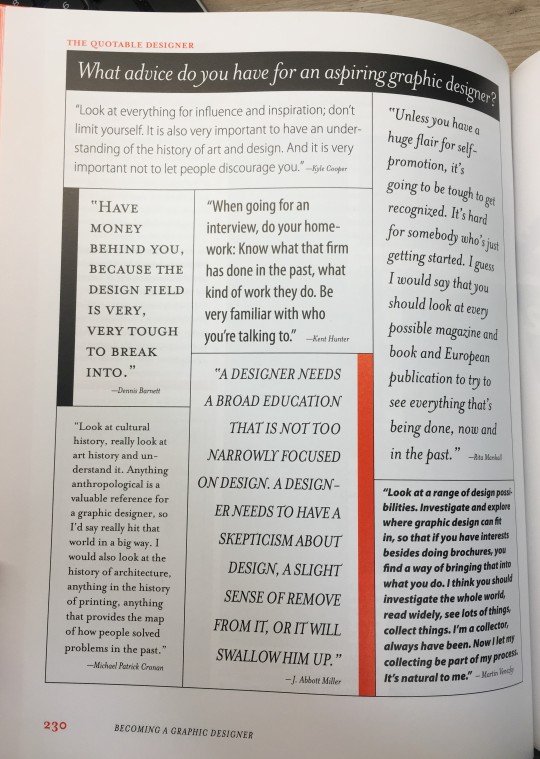
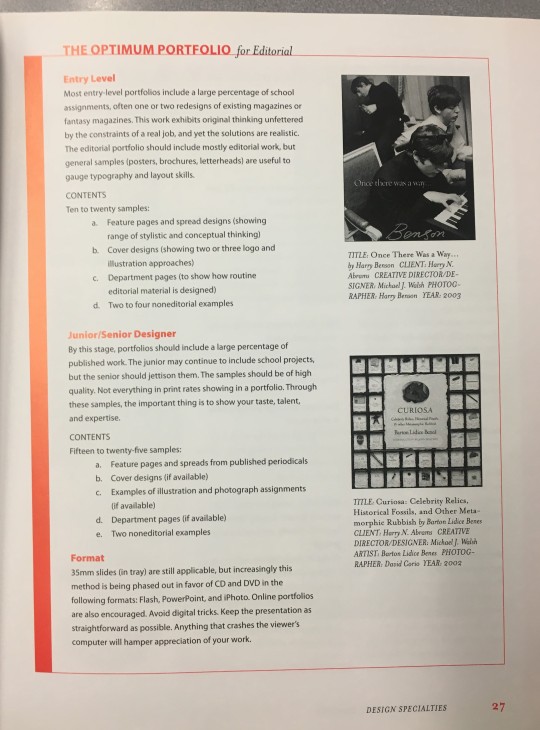

In the industry, it is common for designers to recognised for their work by receiving awards. The most significant award in the graphic design industry is the D&AD Award (https://www.dandad.org/en/d-ad-awards/), which comes in the iconic pencil shape. As the website describes, “The D&AD Awards have been around for 57 years. They stimulate and celebrate creative excellence in commercial creativity, annually inviting 250 of the world’s greatest creative practitioners to judge the year’s finest work. The award is the symbolic D&AD Pencil, and for those who achieve one, it is career defining. The D&AD Professional Awards are recognised globally as the ultimate creative honour, entered and attended by the best from around the world.” The D&AD Award doesn’t only focus on graphic design, but design in general by including other disciplines such as architecture and fashion. Designers applying for the competition know they’re being judged by experts and the best people in the industry.

As the competition hasn’t happened this year yet, I have looked at last year’s winners, focusing on the area of Branding - all of the winners and runner ups can be viewed here: https://www.dandad.org/profiles/jury/733267/branding-2018/. These are two of my favourites:
1. Agency: Jones Knowles Ritchie, Client: Ugly Drinks - https://www.dandad.org/awards/professional/2018/branding/26723/the-ugly-truth/
“Ugly was the first 100% natural, fruit-infused sparkling water to market. To take its message to the masses, it adopted an approach that was every bit as bold and uncompromising as the product. The result? The Ugly Truth campaign that is both provocative and playful in tone.”


What I really like about this is the playful and lively atmosphere – a lot of drink companies attempt to do this, but I don’t think any manage to come across as bold and stand out as much as this one. I also like the contrast between the blue, a colour associated with peace and calm, and the exciting, energetic imagery. I also like the cartoon style.
2. Agency: Interbrand Australia, Client: Cotton On Group - https://www.dandad.org/awards/professional/2018/branding/26746/g-ay-mate/
“G’day mate. The most famous of Aussie phrases. So, when the debate on legalising gay marriage turned sour, Cotton On Group decided to embrace the term as part of the collective fight back. G'AY MATE is a reminder of what it means to be Australian: friendliness, being laid back, and to always give everyone a fair go.”

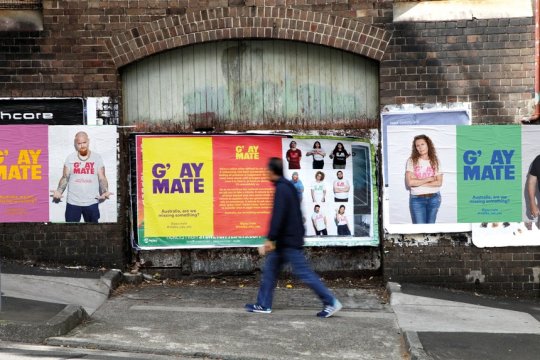
The play on words used is so clever, which helps the audience to understand the message instantly. The reason why the message is so smart because the designer uses the famous Australian saying, and relates that to gay rights by taking out a letter, creating a missing element. The plain design and bold text helps the message to come across also, as there’s nothing else to take away attention.
I personally haven’t ever entered a design competition, however I think it could be a good experience - at the end of sixth form, I was awarded “Outstanding Student” in graphic design as my work achieved full marks and was always consistent in quality and I was so pleased to receive this, so to be recognised by professionals in the industry and win something meaningful could be great.
Library Visit:
From the library visit, I have decided to look at journals that focus on Graphic Design specifically. I came across Communication Arts, which is the largest international trade journal of visual communications, founded in 1959. The issue I looked at was published November/December 2018; it’s the annual advertising journal, where designers submit their best advertising work from the past year. This particular issue was of my interest as advertising is part of the branding area, which is what I want to get into.
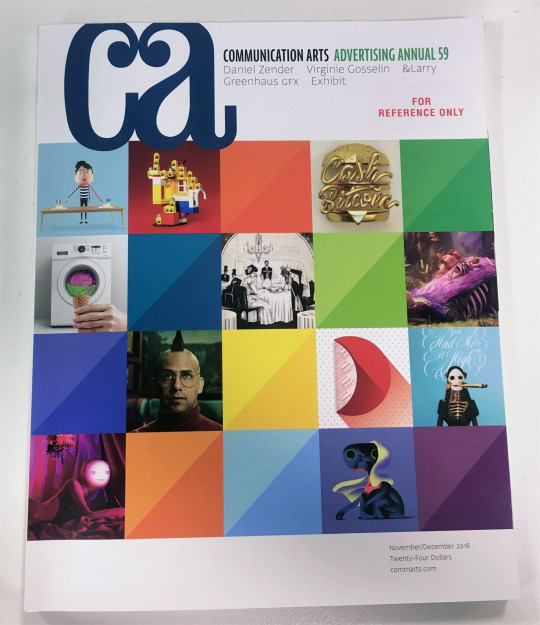
The issue doesn’t only show a number of images of various advertisements; it also discusses how advertising differs nowadays in comparison what it was thought to be a decade ago. Crimi-Lamanna, one of the judges who decided on the images that were put in the magazine, stated that adverts are more common online and on social media nowadays, rather than on television and magazines where they traditionally would be found. She noted that this isn’t a negative thing, as social media advertising allows an opportunity to move from just story-telling and content creation on different platforms to more ‘story doing’, where costumers are invited to participate in a variety of brand actions that prove that brand’s values in unexpected ways. I agree with this, as you can’t interact with an advert seen on television or a magazine, as much as social media which does allow for a new concept. Crimi-Lamanna expands, and mentions all the tools available now that enable brands to get closer to customers; the intimacy created allows a greater connectivity to brands. Additionally, customers have a larger role in advertising now, rather than just being buyers of products – they can question how do we help serve?, and how do we raise awareness of the issues that need attention? Customers are realising that they are the masters of shifting public thinking, and those powers should be used for good. Again, this is something I strongly agree with it, and I think social media is to thank for this, as it’s very easy to create content to advertise and promote yourself if there is something one feels isn’t receiving as much attention as it should – customers are in the same position as advertising companies by doing this.
Moving on, these are some of my favourite adverts I saw in the magazine.

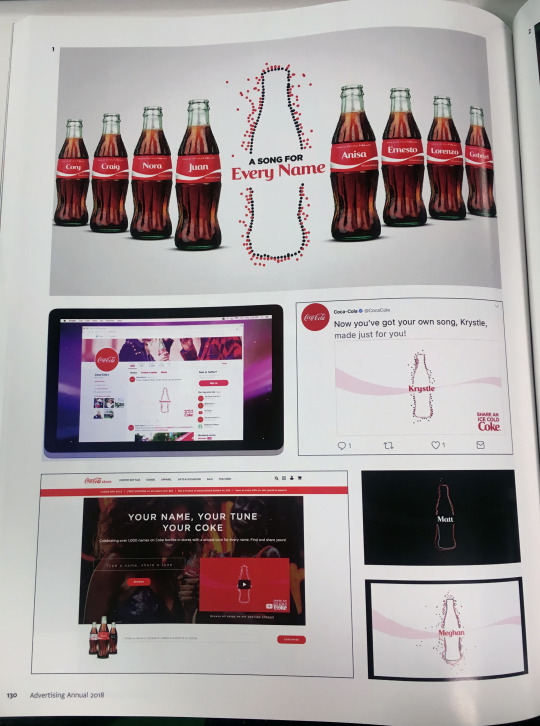


The social media influence is very strong in many of those adverts, in particular the first two. The first one is based on texting, however with a twist as it’s an interaction between a human and a body part of theirs - their liver, which is a really smart way to raise awareness of safe drinking I personally think - it’s fun, but very informative at the same time. The second one is different, as it’s the Coca-Cola company engaging with their customers by creating unique bottles with names on. The other two are beauty based - I really like the collage technique used in the first one, and the mixture of faces as no face on that advert is simply one face. There’s a sense of mistaken identity, which of course matches with what is being advertised as the question of “who” is being asked. The last one I particularly enjoy and especially its use of texture as a way to connect with the audience - common textures are used that most people have come across previously, and the posters don’t ask “does your skin feel like this?” - it’s more firm and assertive, telling the audience to visit this place if they relate.
Action Plan:
As I mentioned earlier, I would like to possibly get into the editorial industry in the future, however, at the moment I don’t have any work to put into my portfolio that is editorial. By the end of the module, I would like to re-create an already existing magazine article and cover, which can be later used in my portfolio as an example of my own editorial work.
Additionally, after researching job advertisements, I want to book an appointment with the Careers & Employment service at the university, so I can discuss about what is needed to write a good graphic design based CV, what to put in a portfolio, how to get experience etc.
0 notes
Text
Week 2 - Networking
I found the lecture all about networking really useful as I had no idea how to network before attending and the thought of it scared me slightly, but after I was full of ideas and knowledge how to network successfully. I have decided that the best way for me to network is through social media as this is what suits my personality type the most; I don’t feel too confident yet to be able to meet up with designers in person or to start a conversation out in public, but after attempting at networking through social media I’m hoping this will change. The first step to networking online was to create a space where my work can be displayed. This is something I haven’t done this previously, so I’ve decided to research what the best platforms for doing this are. I have used Digital Arts website as a reference, and specifically this article titled “16 Best Portfolio Websites for Designers and Artists” which can be viewed here: https://www.digitalartsonline.co.uk/features/creative-business/16-best-portfolio-websites-for-designers-artists/. On the very top of the list Behance is listed, and this was a site I have heard of before - I’ve seen many designers use Behance; it’s very popular especially within the graphic design industry. So of course I’ve then decided to check the website out: it seemed like a great choice as the website allows for clear organisation and ease to find out more about the designer, by accessing the profile section. I’ve created my own profile, using some of my favourite design work I’ve created at university and A Levels and designs created in my spare time too. However, I haven’t uploaded everything at once - by uploading work gradually, I will create more interest around my profile hopefully. This is what my page looks currently; I definitely need to work on gaining a following, views, etc., but this will need further research into how to do so. My page can be viewed here: https://www.behance.net/anna_zukowska.

After setting up my Behance page, I have decided to start networking using social media and have used a forum as a start as recommended in the lecture; a graphic design dedicated forum specifically. I have created accounts on two different forums:
Talk Graphics: https://www.talkgraphics.com/index.php,
and Graphic Design Forums: http://www.graphicdesignforums.co.uk/.
On there, I’ve posted the same message:
“Hi! I'm Anna, and I've just joined the forum today. I am currently in my second year at university studying Graphic Design, and just was wondering if someone experienced / professional could tell me a little bit about their experience, so about how you got into the field - did you also study at university or went for an internship or something along those lines instead? When getting your first job, did you get it through contacts you've made and people you knew, or did you apply through a job site and had an interview? What was your first job like, and what do you currently do? I'm just really interested about people's experiences and how they got to where they are today, and what kind of things to expect in general. Thank you for your time and any replies short or detailed are very much appreciated.”
I’ve had two very different experiences posting the same message on the two different sites - luckily, I’ve managed to get a reply on both forums.
After posting my message on TalkGraphics, I’ve had a reply from an account called gwpriester about an hour or so later, with the following message:

From this, it’s obvious that the designer replying to me was very experienced, having graduated in 1967 with a major in advertising design, and then working for 15 years as an advertising art director, followed by their own graphic design company in San Francisco for 12 years. They stated that they got into the industry due to the reputation of the college they attended; there wasn’t much of a story there in all honesty. However, they added that they helped their wife get into the same industry by advising her to re-design adverts she thought weren’t very good, and slowly building up a portfolio from this. I thought this was an excellent tip as I struggle coming up with ideas for new and original businesses at times, so re-designing current ones is something I can try too. They also gave two other pieces of advice: one was to always do more than what is expected of assignments, and the second being to take inspiration from the best designers in the industry and match their creativity. Again, I thought this was great advice, and something I will keep in mind for the future. I found this interaction really useful, however, it felt very formal and I felt like I didn’t have anything to add as everything I was curious about was answered. I simply thanked them for his time, and nothing followed this. This thread can be viewed here: https://www.talkgraphics.com/showthread.php?80764-Aspiring-graphic-designer-looking-for-tips-and-advice-)
Update - 8th May: I have re-visited the thread I’ve posted couple of months ago, and to my surprise it has many replies now, varying from designers who have been in the industry for years, but also more contemporary ones. They all gave a brief outline of how they got to the position they are in now, which is so interesting to read as each story is so different. This has taught me that networking can take time, as within time, I managed to get all these various replies.
On the other forum, Graphic Design Forums, I’ve also had a reply from an experienced designer, this time going by the username sprout. This was the first reply after I put up the same message:

Sprout highlighted the struggle a beginner graphic designer may face with being constantly turned down at first when applying for jobs as it’s a really competitive field, and said that it’s not easy but nothing worth having ever is which I liked as I completely agree with. Again, I was talking to someone really experienced which is useful to me; they stated that they don’t image the process of becoming a designer isn’t much different to what it used to be when they first started. What interested me in his reply is his decision to move to London to start their career, so I’ve decided to ask about this further. I got yet another reply:
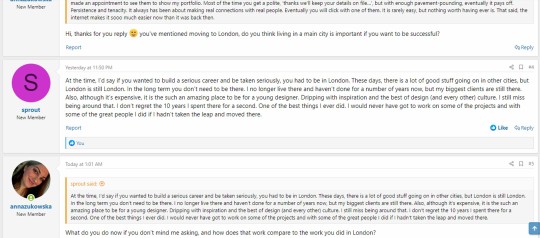
From what I understood, back when they were trying to become successful, it was quite important to move to London, or any major city in order to succeed due to the lack of internet and other resources back then. However, nowadays it’s not as vital as you are able to work from wherever. I’ve found sprout’s replies very interesting, and decided to ask about what they do now. Unfortunately, there wasn’t a reply until later on today: I’ve received a private message, as they didn’t want to talk about themselves publicly so much, which is completely understandable.

This time, the reply felt more personal as I now knew the designer’s name - Keith. He stated that he works in publishing most of the time, with some of the time also being spent in corporate and web design. He also stated that he spends a tiny amount of his time doing design work for charities, so I assumed this was working for free which I found to be very generous and interesting as I haven’t come across many designers who do this. In the second part of his reply he started to pay interest in me by asking me what areas I am looking to get into, and expanding on the moving to London conversation, and advised that it wasn’t necessary nowadays, relating to his experience directly once more: he moved to Italy for a short while and still managed to maintain his UK based customers. What I enjoyed the most about his reply is his sense of humour; he joked about his age and how he felt old talking to someone as young as me. I think this created a bond between us, and I was encouraged to keep on replying. I replied talking about the areas of graphic design I like to work in, so branding and web design, and anticipated another reply, which shortly followed:

Keith explained his preferred areas of work, which was also branding but now I have also found out he enjoys animation - he attached his typographic animation to the message. I found this inspiring as I am not overly keen on animation, but really enjoyed his due not seeing many typography based animations before. I can imagine myself creating something like this too maybe someday. This video can be viewed here: https://vimeo.com/190997734. As a user is unable to send attachments on the forum, Keith asked for my email address in order to send me more of his work I asked to view; I received an email with the following work,

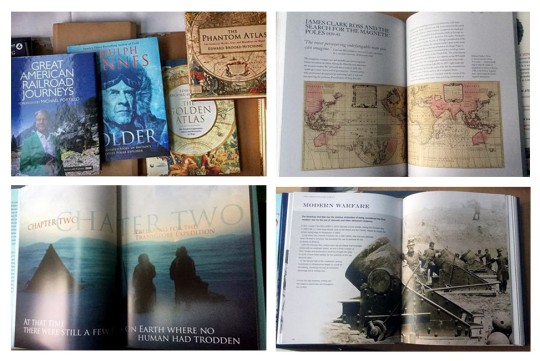
and the following links: his outdated, 10 year old porfolio: https://shared-assets.adobe.com/link/f0b08349-46e9-454e-9588-c9affbef585e, and his photography work: https://stock.adobe.com/uk/contributor/204879575/sproutphoto?load_type=author&prev_url=detail. I really enjoyed looking at Keith’s photography work as it’s one of my interests too. I’ve sent an email back shortly, thankful for him sending his work over to me - it’s really different to see and talk to the designer about their work personally, in comparison to just looking at it on on their website or social media as you get the chance for them to explain what they did and why. Receiving those images allowed me to get a true insight into his work, his personality and his journey into becoming the designer he is today. This next reply I received I was particularly pleased with - Keith took time out of his day to look at my work using the Behance link I sent him much earlier on, and started asking me about my studies, all showing real interest:

At this point, I felt that I was really happy with my networking progress as I remembered from the lecture that it’s important to build a connection and friendship, which is what exactly I was doing with Keith then. This happened as we bonded over my hometown of Leicester, which is where his friend lives, and he also has a cousin in Derby. He additionally complimented my work, calling it vibrant and coherent which gave me confidence as I received a positive comment from a professional who’s been in the industry for a long time and has most likely seen his share of poor design. At the end of the email, he offered to help me out in the future - he offered his feedback on my work, and the permission to email him whenever with any help, advice or questions I had. I will definitely use this in the future - I’d say my first attempt at networking was a great success as now I have a designer in my contacts who I can message when needed.
The reason I chose to speak to Keith more in comparison to the other designer who also replied on the other forum is that I felt more of a connection with Keith - we were both interested in each other’s work and views, and the reply from him at first didn’t feel so professional and formal which made me feel comfortable enough to ask further questions.
Action Plan:
As I have a Behance account now, I will need to work on it: I need to build a following, find designers to follow myself, and try to gain more views and appreciations on my work - I really would like to get my work ‘out there’. To be successful in doing this, I will research methods of ways to get your work noticed, and interesting designers to follow, as well as how to get more of a following yourself.
0 notes
Text
Week 1 - My Story
I’m Anna, and welcome to my blog. So, first of all, who am I? Why am I at the University of Derby? Why graphic design? Let me explain it all.

Me, last summer.
I am currently 20 years old, and a graphic designer in the making. I’ve always been creative, being able to draw quite well from a young age and having a vivid imagination for as long as I can remember. My first experience with graphic design was when I was 14, when I picked to study the subject as one of my GCSES. Although, this is can be debated as when I was a child I was constantly drawing and loved to create my own magazines, books and cards, so technically I was creating graphic design content despite not knowing what it exactly was! The reason I didn’t know what graphic design was growing up is that I don’t come from a creative family - most of my family work in the food and hospitality areas, therefore I didn’t know about the possibilities of studying and pursuing a creative career until I was 13/14. This world opened up slightly more to me through art lessons at middle school where art was taken more seriously and I got given projects that lasted a couple of weeks; I found myself really enjoying the subject, so I’ve chose to also study it alongside graphic design at GCSE. At GCSE, I found it difficult to enjoy the subjects where I wasn’t able to be creative, but despite that I always tried my hardest as I have always had high standards for myself. This is also when I considered working in the creative field even more, and decided to take graphic design onto even further study towards the end of my GCSES, so at A Level, before eventually deciding it’s what I want to study at university and definitely take up as a career. Despite not choosing to pursue fine art, I am very much still interested in the subject, and visit museums and galleries when I can – recently, I was lucky to visit the National Gallery in London, as well having been to Tate Modern & Tate Britain and National Portrait Gallery previously; all those visits have inspired me in someway.


1. Tate Modern building, own photography, 2016
2. The Water-Lily Pond by Claude Monet (1899) at The National Gallery, own photography, 2018
I also support local artists, which is refreshing as there’s an opportunity to see different type of art in comparison to what is displayed in famous museums. I support local artists by attending a yearly event, back in my hometown of Leicester: the Art House. Local photographers, graphic designers, fine artists, sculptors and such who live in a specific area open up their houses and invite people to view their work space and studios, and there’s also a chance to talk to them in person and purchase their work.


An artist I admire and hope to view the work of one day is Frida Kahlo - I love the uniqueness in her self-portraits, and in particular the composition she used where she surrounded herself by various objects such as monkeys and birds, as seen in the 1940 artwork Self-Portrait with Thorn Necklace and Hummingbird, which can be viewed here: https://www.fridakahlo.org/self-portrait-with-thorn-necklace-and-hummingbird.jsp. Another artist I really enjoy the work of is Andy Warhol, and specifically his printmaking technique. Warhol is the artist that introduced me to the world of printmaking - it’s a technique I try to use in my work when possible. Screen printing in particular is my favourite, along with letterpress which I experimented with at university last year - it was a really interesting technique as it’s so rarely used nowadays. A range of Warhol’s screen prints can be viewed here: https://www.masterworksfineart.com/artists/andy-warhol.


Screen print and letterpress I created at university last year.
Another aspect of Warhol’s work I find inspiring is the focus on icons and celebrities – I am very interested in popular culture, and again it’s something I like to focus my own work on.
Just like Warhol, my two favourite graphic designers are also influenced by popular culture. The work of Chip Kidd is something I’m influenced by, as I also use minimalistic design, bold colours, black outlines and a combination of photography / digital illustration and typography in my work. Kidd shows great versatility which is one of my strengths too; his versatility is what makes him one of the most influential designers over the past couple of decades which I agree with as he has designed some of the recognisable designs today, such as the Jurassic Park logo. All his work can be viewed here: http://chipkidd.com/home/portfolio-3/. In contrast, a contemporary, less-known, graphic designer I also look up to is Ben J. Crick, and his work for Spotify specifically. Crick re-invented Spotify’s advertising campaign - he added colour, fun and liveliness to billboards and posters, understanding that this is what the brand promotes and it’s what would catch the public’s attention. This type of attention to detail and understanding of customer’s need is what I aspire to be able to demonstrate too. Crick’s work for Spotify can be viewed here: https://www.bjyg2017.com/spotify/.
Apart from graphic design and fine art, I also am interested in photography, although it’s more of a hobby now in comparison to when I studied at A Level. I still try to include photography in my work when suitable as I really enjoy mixed media work and being able to use my own photographs.
Although I do experiment with mixed media and printmaking, my preferred type of work is digital, and I am very confident in using Adobe Photoshop, Illustrator and InDesign, and used those to create posters, leaflets, editorial pieces, logos etc. The area of graphic design I think suit me best is marketing and branding as I enjoy getting to know a brand and their identity, and mimicking that in my own work; although this can result in quite a limited structure to work with, I enjoy having a clear, set way of work.
Just like I enjoy having a clear structure to work with, I also enjoy that in my day-to-day life; I would call my personality reserved and organised. I don’t procrastinate as I prefer starting a task / project as soon as I receive it because this is when I’m inspired the most. I have excellent time management, which allows time for improvement to ensure I am delivering everything to my best ability, and nothing is rushed. I am also very precise, careful and have a keen eye for detail.
According to the Type Dynamic Indicator personality test I have taken, my personality type is defender (ISFJ-A). This personality type is quite unique as though sensitive, defenders have excellent analytical abilities; though reserved, they have well-developed people skills and robust social relationships; and though they are generally a conservative type, defenders are often receptive to change and new ideas. Defender personalities are often meticulous to the point of perfectionism, and they can always be relied on to get the job done on time. Defenders take their responsibilities personally, consistently going above and beyond, doing everything they can to exceed expectations and delight others.


Strengths include:
Supportive – Sharing knowledge, experience and time with anyone who needs it.
Reliable and patient – Rather than offering sporadic, excited rushes that leave things half finished, defenders take a steady approach and bending with the needs of the situation just enough to accomplish their end goals.
Imaginative and observant – Defenders are very imaginative, and use this quality as an accessory to empathy, observing others’ emotional states and seeing things from their perspective.
Loyal and hard-working – Given a little time, this enthusiasm grows into loyalty, defender personalities often form an emotional attachment to the ideas and organisations they’ve dedicated themselves to.
Good practical skills - Defenders have the practical sense to actually do something with all this altruism. If mundane, routine tasks are what need to be done, Defenders can see the beauty and harmony that they create, because they know that it helps them to care for their friends, family, and anyone else who needs it.
The full results can be viewed at: https://www.16personalities.com/isfj-personality. I think that this personality test describes me extremely accurately, and evidently, I have many suitable qualities that allow me to become a successful graphic designer.
Action Plan:
I think the next step for me is to emphasise and really show off the skills I have mentioned such as printing, photography, drawing, etc., and include those in my work more often instead of always referring to digital format. Those skills will make my work stand out as not everyone has the ability to do those skills. I will aim to apply these skills to my current and new projects at university, so this is an ongoing goal until I finish university.
0 notes